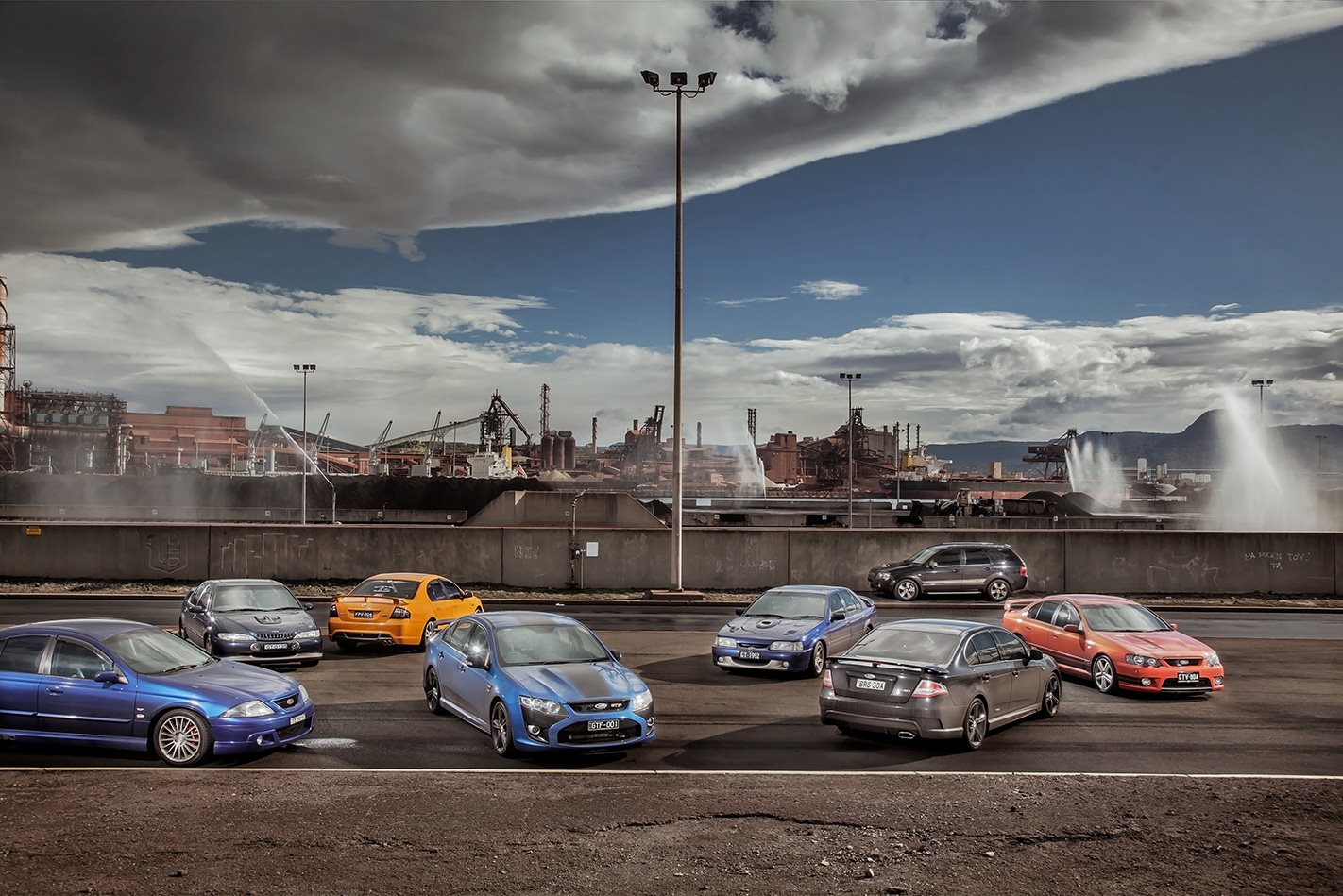“It’s been in my blood since I was a kid.”
This story first published in MOTOR October 2014.
“When you’re growing up, you’re either Holden or you’re Ford, and I fell on the Blue side,” explains lifetime Blue Oval man, BA Falcon GT owner Rob Maricic, when asked “Why an FPV?”
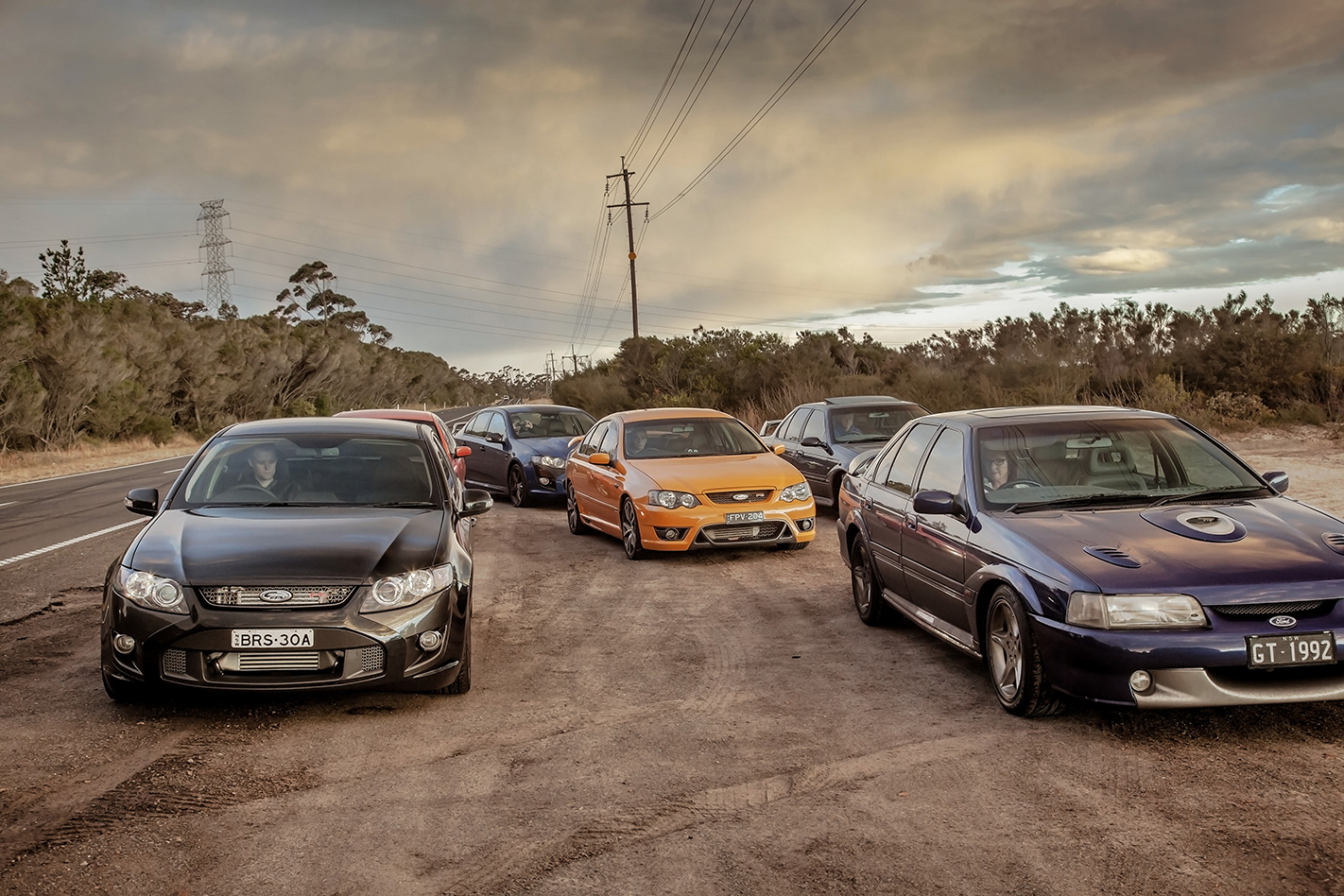
Sure, members of the FPV Tickford and GT club of NSW share an unwavering passion for Henry’s finest, but the theme is of acceptance of other marques and there’s a unifying love of high-performance cars.
Of course, with the last of 550 limited-edition FPV GT F sedans soon to roll from Broadmeadows, and the Ford-owned operation set to shut up shop later this year, they’re not exactly left much choice. However, you get the strong impression these FPV enthusiasts – and Aussie car buyers today – are worldly and opportunistic rather than naïve and rusted-on.
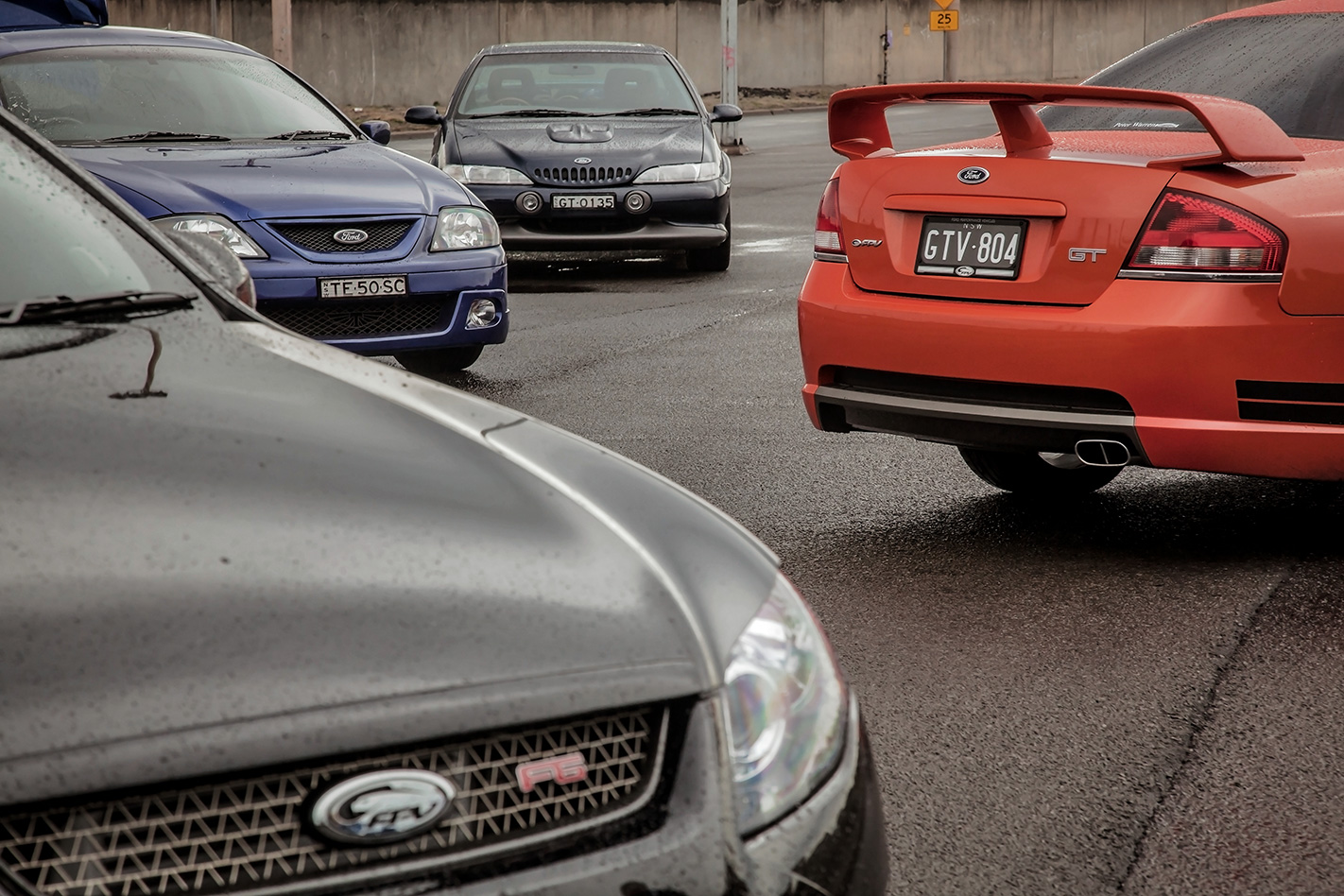
But this is a celebration, not a lesson in shifting buyer tastes or Australian manufacturing woes, and it’s no time to cry into our locally brewed lager.
Enthusiastic EB and EL Falcon GT owner Simon Roche certainly won’t be when FPV wraps up. While he reckons FPV’s demise is “a shame” his tastes are firmly ingrained in the Tickford chapter of the factory-fast Falcon story. He’s bored with V8 Supercars and finds many of FPV’s more recent offerings “too common.”
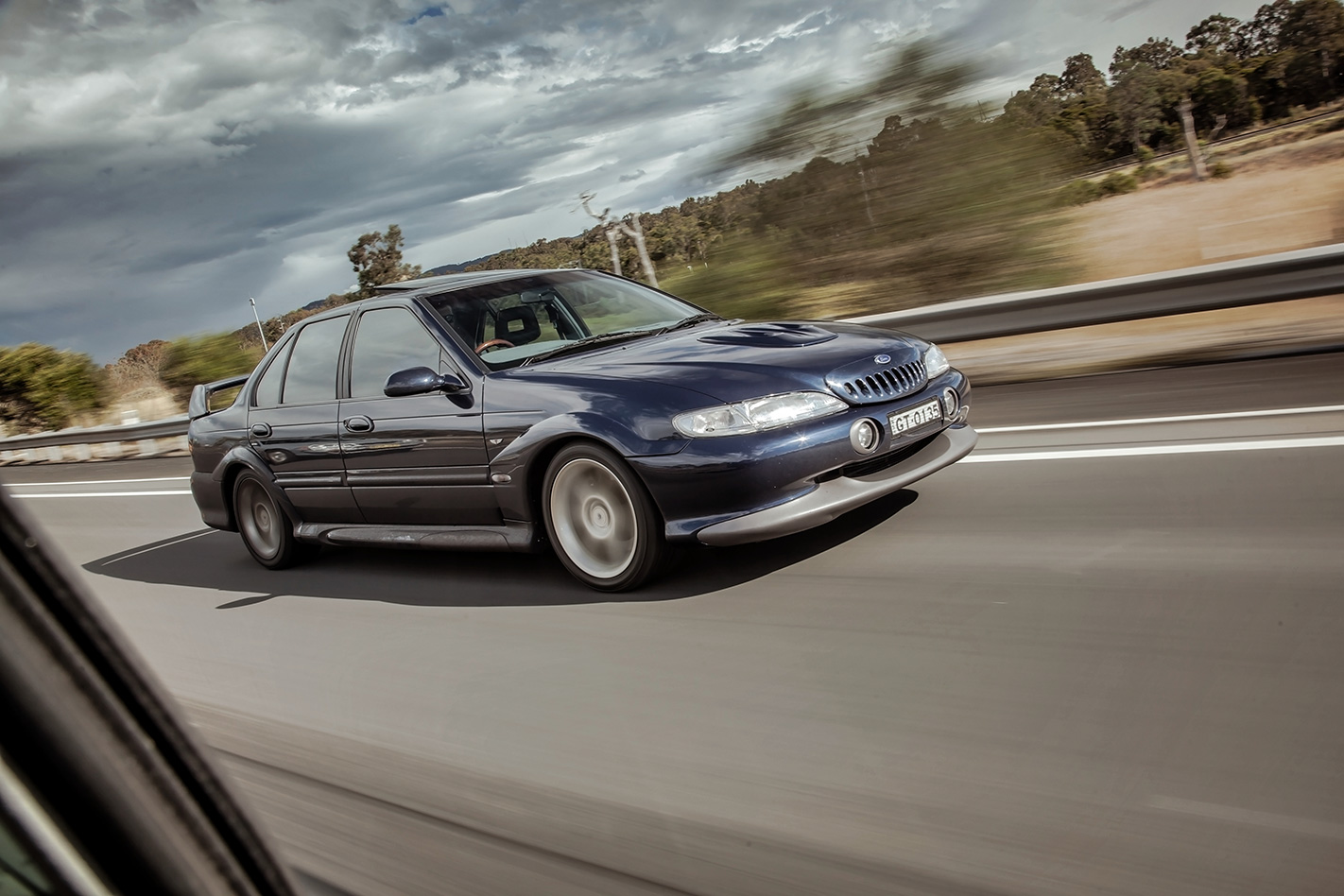
But, at the same time, it’s quite clear that his EL GT – owned from near-new – isn’t going anywhere, and he’s already at work on his wife Katrina for a 40th Anniversary FPV GT to park alongside the 25th Anniversary EB Falcon GT he bought recently as a 25th wedding anniversary gift to himself.
The reborn GT arrived in 1992 to kick off two decades of Tickford Vehicle Experience and Ford Performance Vehicles, and marks the intersection of the Aussie GT legend spawned by 1967’s XR Falcon and a Tickford story that began in Britain in the 1820s.

In the late 1950s the Tickford name vanished, not to resurface until 1981, as Aston Martin Tickford. It took on the role of engineering and tuning company and would be responsible for such motorsport icons as the Ford RS200 and Sierra Cosworth RS500 among other road and race cars.
In 1990, Tickford’s directors bought out the ailing company, reviving it and taking on R&D for Ford’s Focus RS. Then, in 1991, Tickford was chosen as partner by Ford Australia – Tickford Vehicle Engineering became the high-performance arm of Ford in Oz.
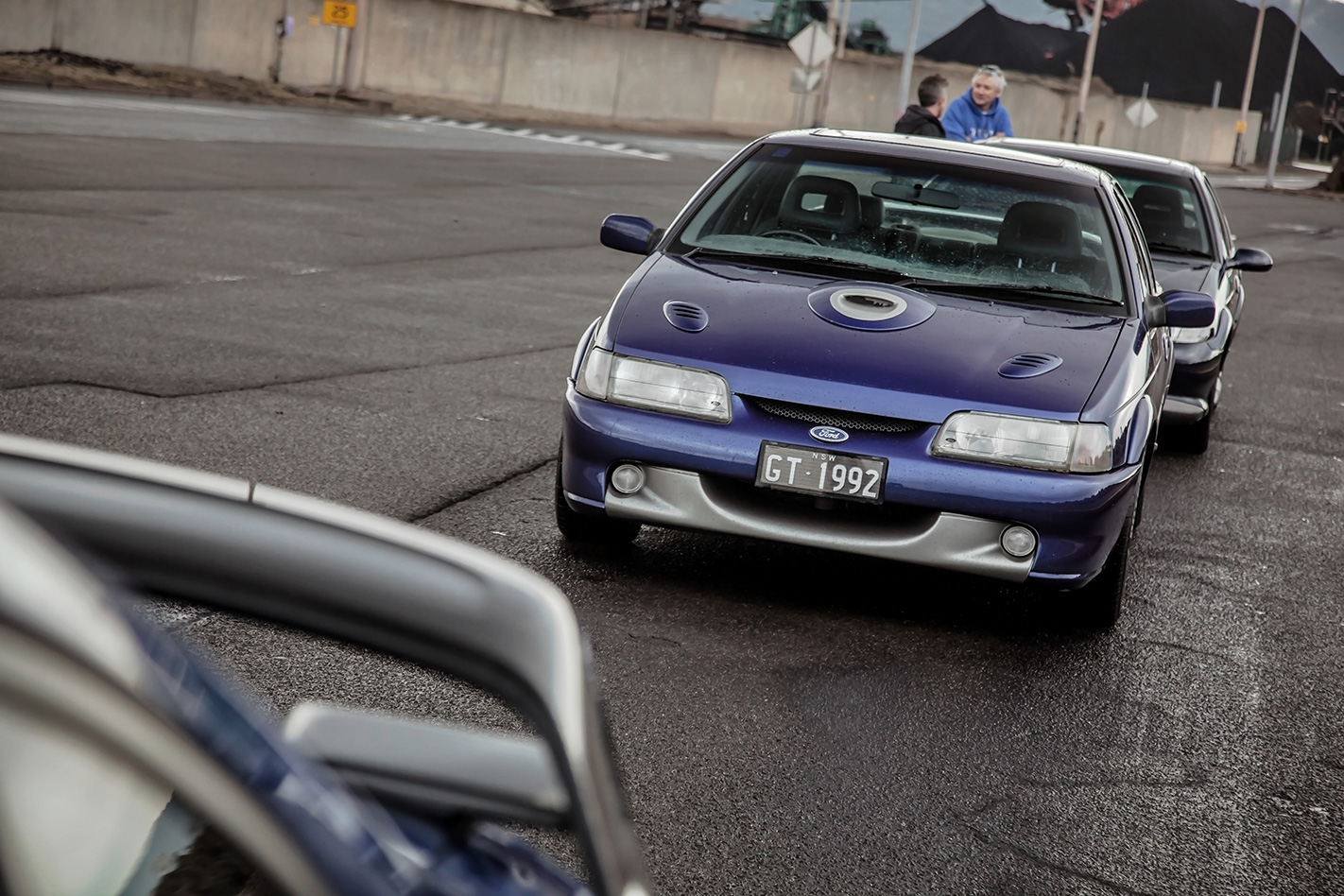
However, that certainly wasn’t possible in the early ’90s. Picture it. The Ford V8 had been on hiatus since 1982, when it had bowed out in 351 cubic inch Cleveland form in the XE Falcon. Now, the bent-eight was back in the form of the 302ci (5.0-litre) Windsor in a special hi-po version of the series two EB Falcon, which represented the first update of the fifth-generation model born as the EA in 1988.
The XR series aesthetic package was restrained, but their performance was attention-grabbing.
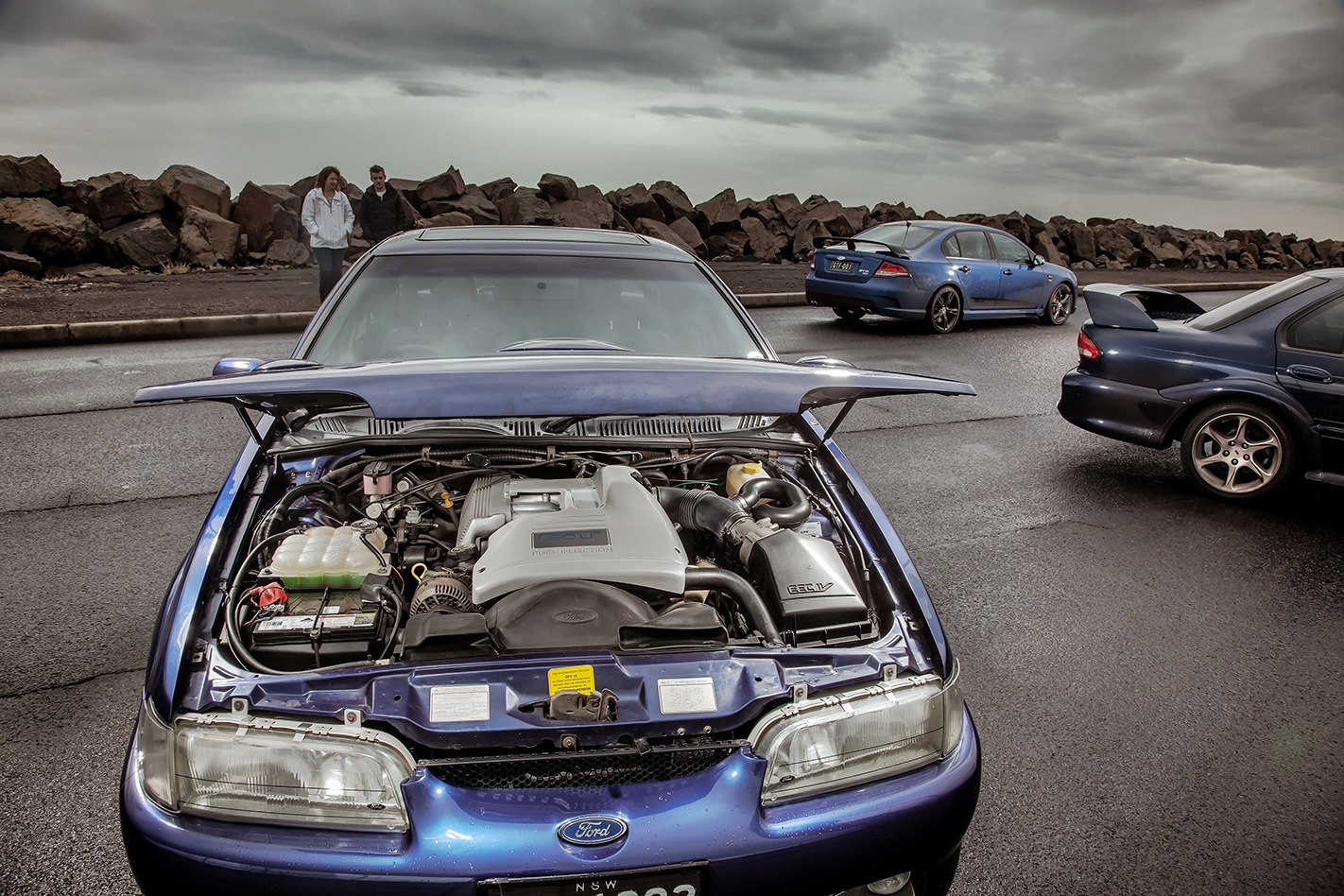
It took the limited run of 265 EB GTs to put the V8 back on its pedestal, though plenty of motoring pundits reckoned it lacked the performance to live up to the GT legend, which had been gathering dust since 1976’s XB GT. Contemporary road tests put it at mid 7s to 0-100km/h and mid 15s across the 400m – it was no Phase III.
At the EB GT’s launch the late Howard Marsden, Ford Tin Top racing mastermind, explained: “Thankfully, we now have a set of rules for touring car racing that spare participating car manufacturers from having to make road-registrable homologation specials like the GT-HO,” concluding that, “Like the latter-day GTs, the EB is not a race car.”

The EB GT’s sequentially fuel-injected overhead valve V8 was sourced from the US-market Mustang Cobra before being Tickford tuned via camshaft, cylinder head and air intake changes to deliver 200kW at 5250rpm and 420Nm at 4000rpm. Down the driveline, the only changes from the XR variants were gear ratio and auto shift points. Yep, the GT came as a four-speed slusher as well as a five-speed manual.
Surprisingly, the suspension was softer than that of the S-XR6 and 8 – GT now spelled Grand Touring rather than Bathurst special. At least it wore big (for the time) 17×8.5-inch wheels of an attractive five-spoke design.

But the fact widespread collector’s car recognition has eluded the EB GT didn’t put Simon off. Rather, the model’s relative affordability helped when he finally bought his in March, a Cobalt Blue 1993 model. “I’ve always like the EB shape – maybe it’s something that I couldn’t afford back then when the interest rates were so high, and I thought … one day.”
Five years after the EB, there was a sense of déjà vu surrounding the arrival of the 30th Anniversary 1997 EL Falcon GT. It was again a case of too much luxury, not enough performance, but this time it came wrapped in a polarising styling package.
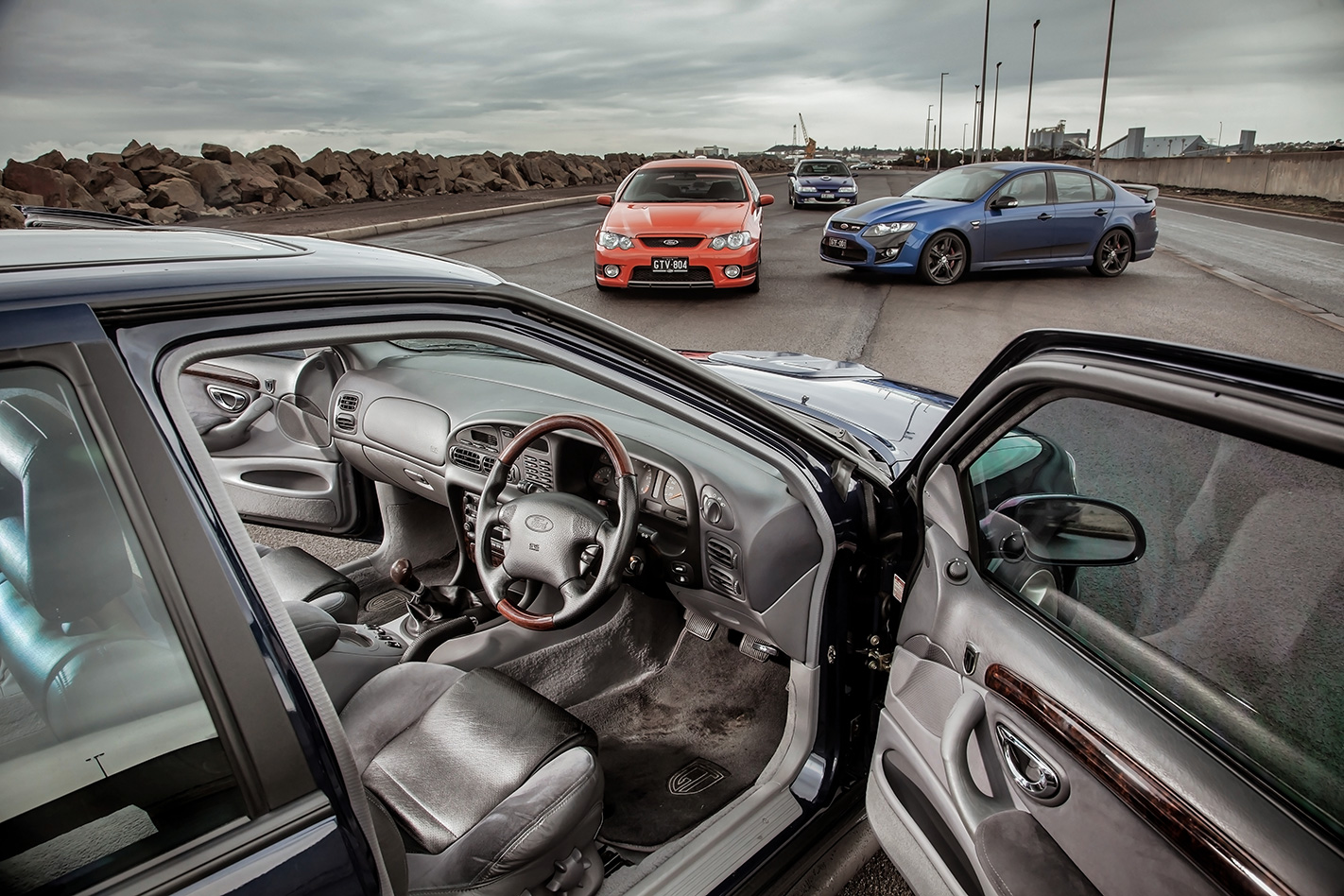
The frontal styling might have been a turn-off, but the mechanicals – and straight-line performance – improved subtly compared with the EB GT, although peak outputs were unchanged and kerb weight was up slightly to 1674kg (manual).
The 9.0:1 compression SVO GT40 5.0-litre boasted a large throttle body, free-flowing cylinder heads, big valves with heavy-duty springs, roller cam followers and a more sophisticated fuel injection system. Four-speed automatic and five-speed manual BTR transmissions were offered, powering down via a 3.45:1 Hydratrak limited-slip-diff-equipped live axle located by a Watts linkage.
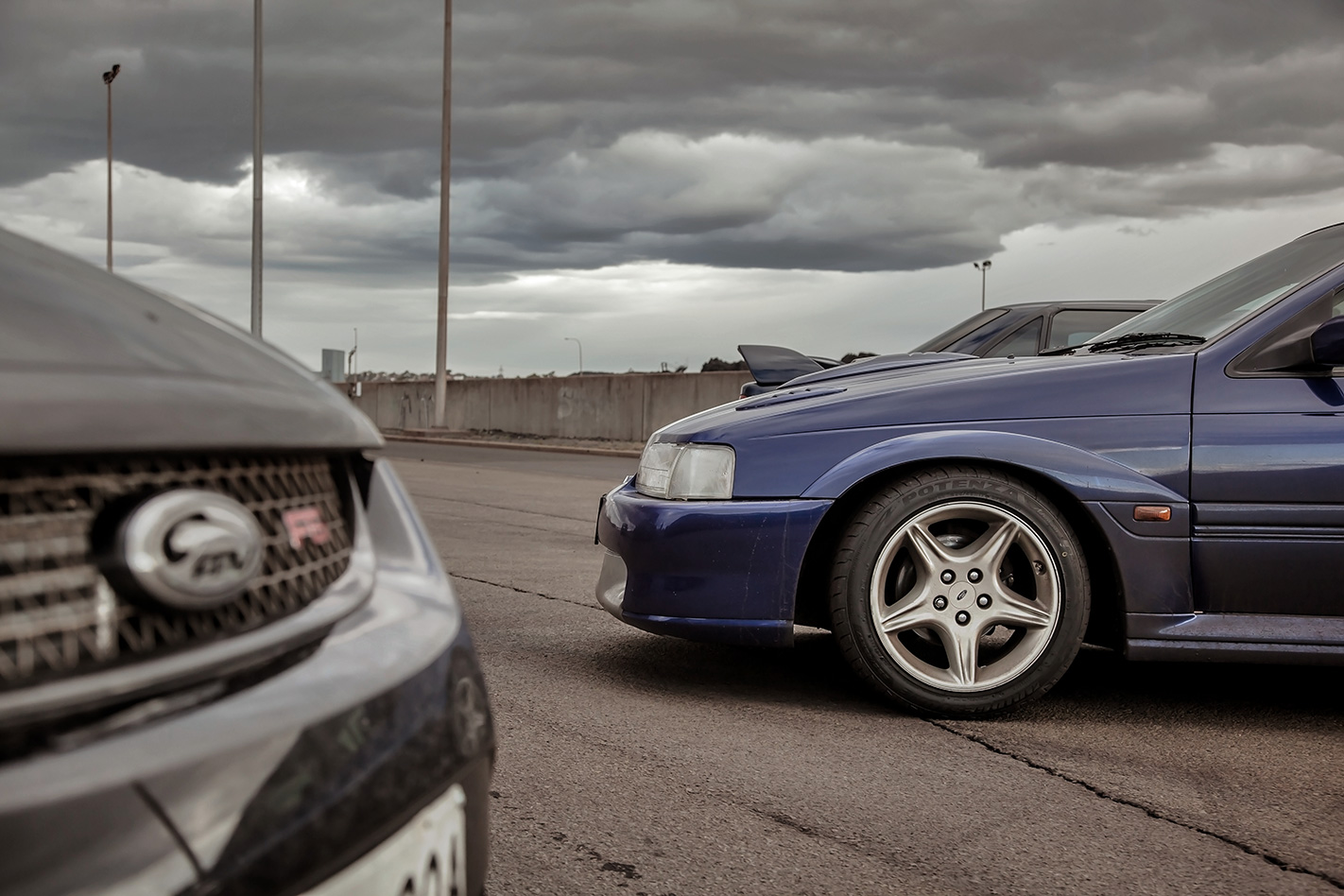
The brakes were upgraded with two-pot front calipers, and were cloaked by six-spoke 17×8.5-inch alloys.
If the familiar-sounding mechanical package – and story – wasn’t enough to motivate buyers, for some the Falcon’s revived presence on local motor racing circuits was.
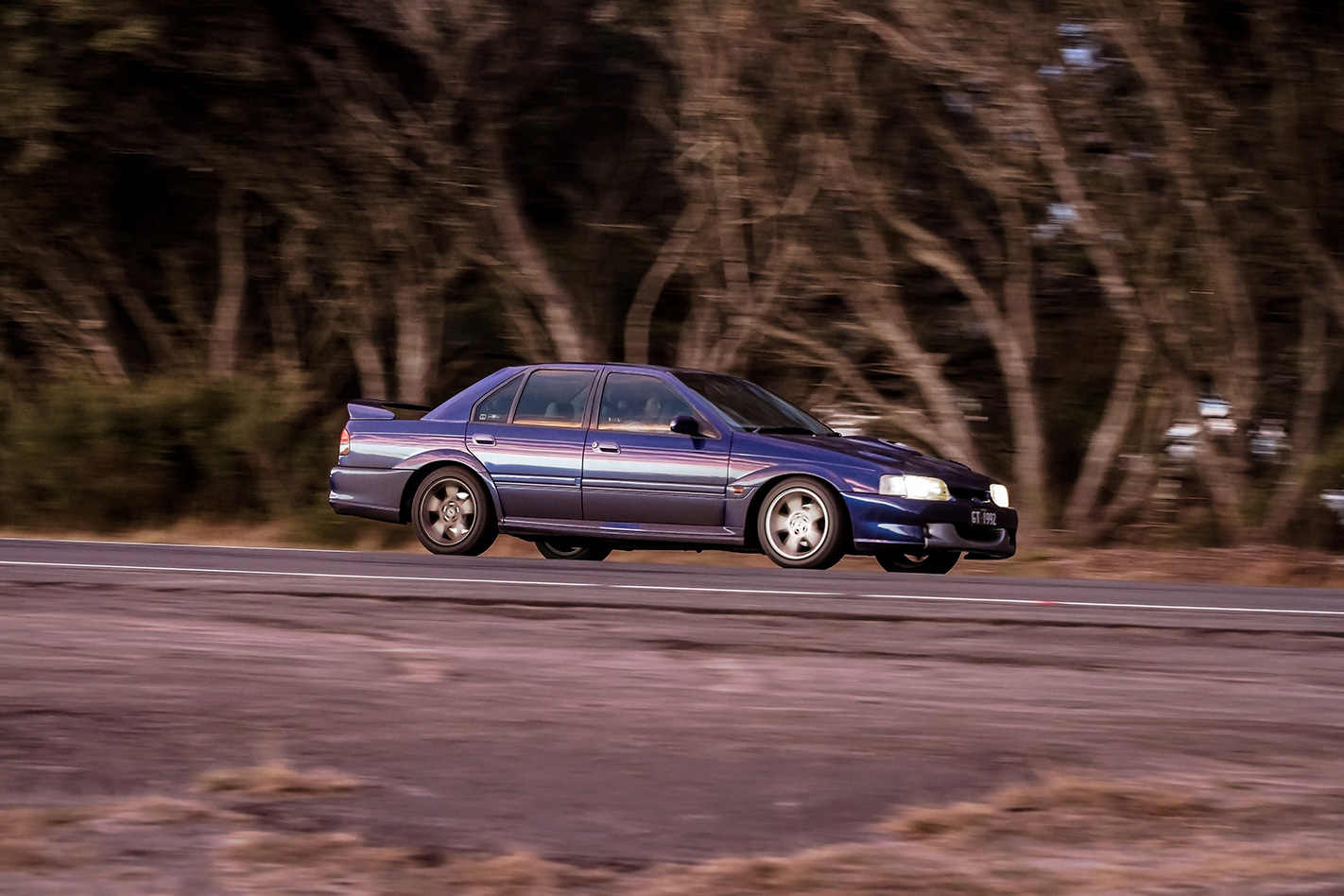
Indeed, the availability, once again, of a V8 Falcon, had made possible 1993’s new bent-eight-friendly Group 3A Touring Car formula, which replaced our adopted Group A regulations and went on to become V8 Supercars.
Glenn Seton won the Australian Touring Car Championship in his EB Falcon in that inaugural year, while Dick Johnson Racing’s 1994 victory at The Mountain broke a five-year Blue Oval drought, and marked 13 years since a Falcon had taken the chequer.
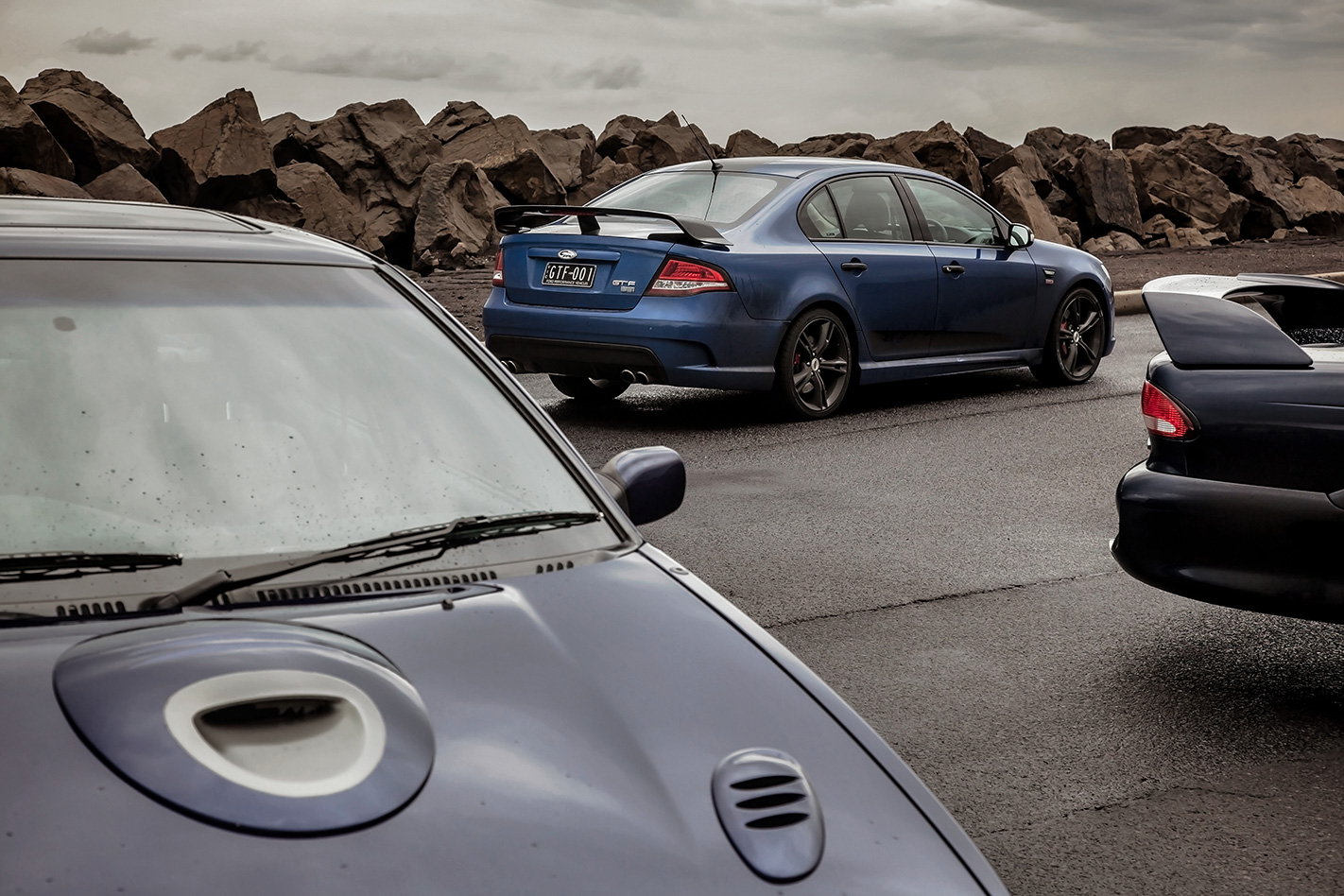
Falcon ATCC victories in 1995 and ’97 were crowned by Jason Bright and Steven Richards’ 1998 Mount Panorama success at the wheel of the Stone Brothers Racing Pirtek EL Falcon. The GT might’ve gone a bit soft, but Ford was back on the local motor racing stage.
However, there was a loyalty test in store for hi-po Falcon fans. If they’d found the styling of the EL GT difficult to swallow, 1998’s New Edge AU Falcon brought confronting aesthetics to the entire sixth-generation Falcon line-up.
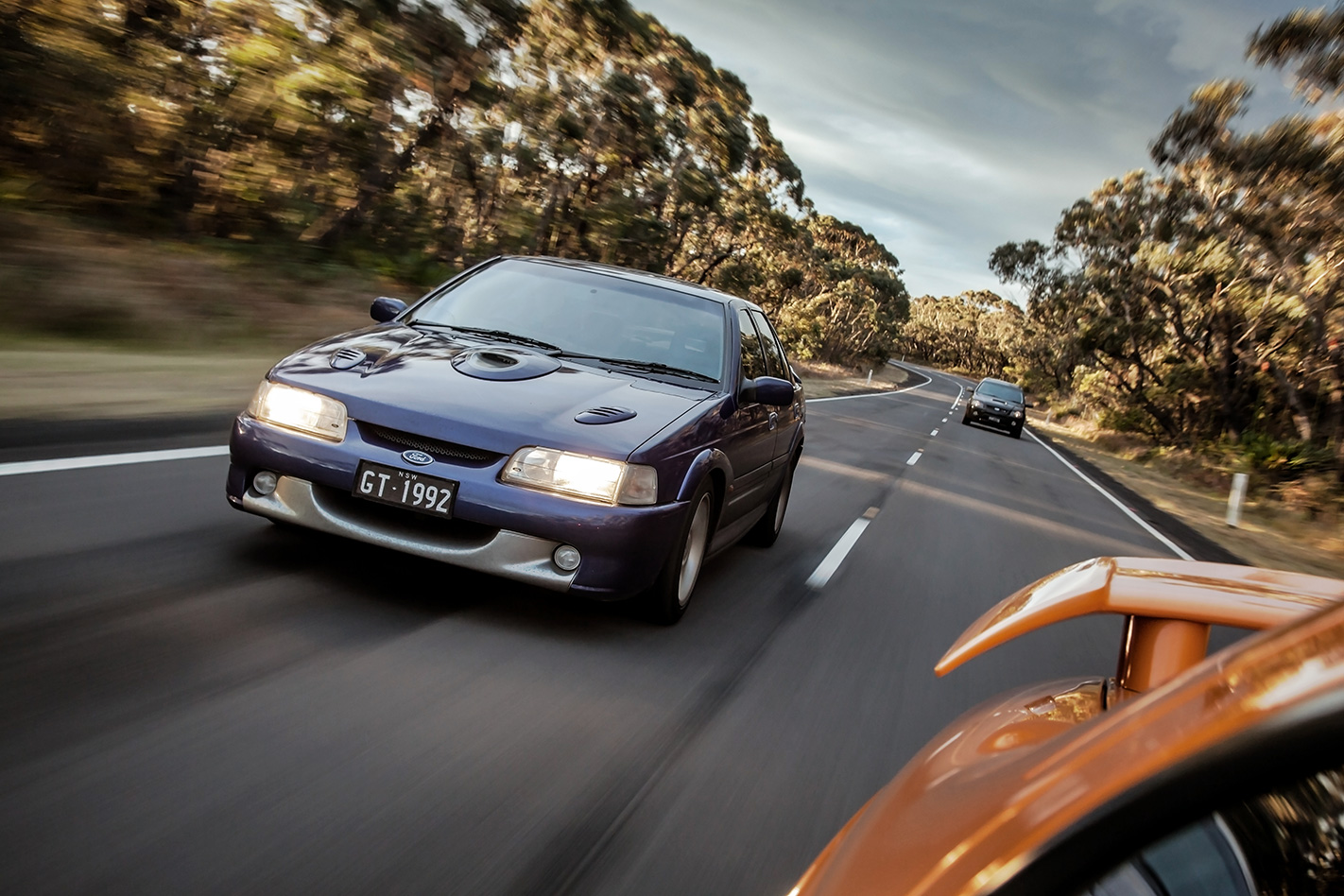
As the curtains closed on the ’90s, TVE, under its new Ford Tickford Experience banner, delivered its AU Falcon and Fairlane-derived T-Series range.
At this point, FPV’s cross-town rival Holden Special Vehicles comes firmly into the frame. Clayton’s Holden hot-shop had been on the scene since 1988 and, with its Clubsport and GTS front and centre, had enjoyed more than its fair share of the home-grown hi-po segment.
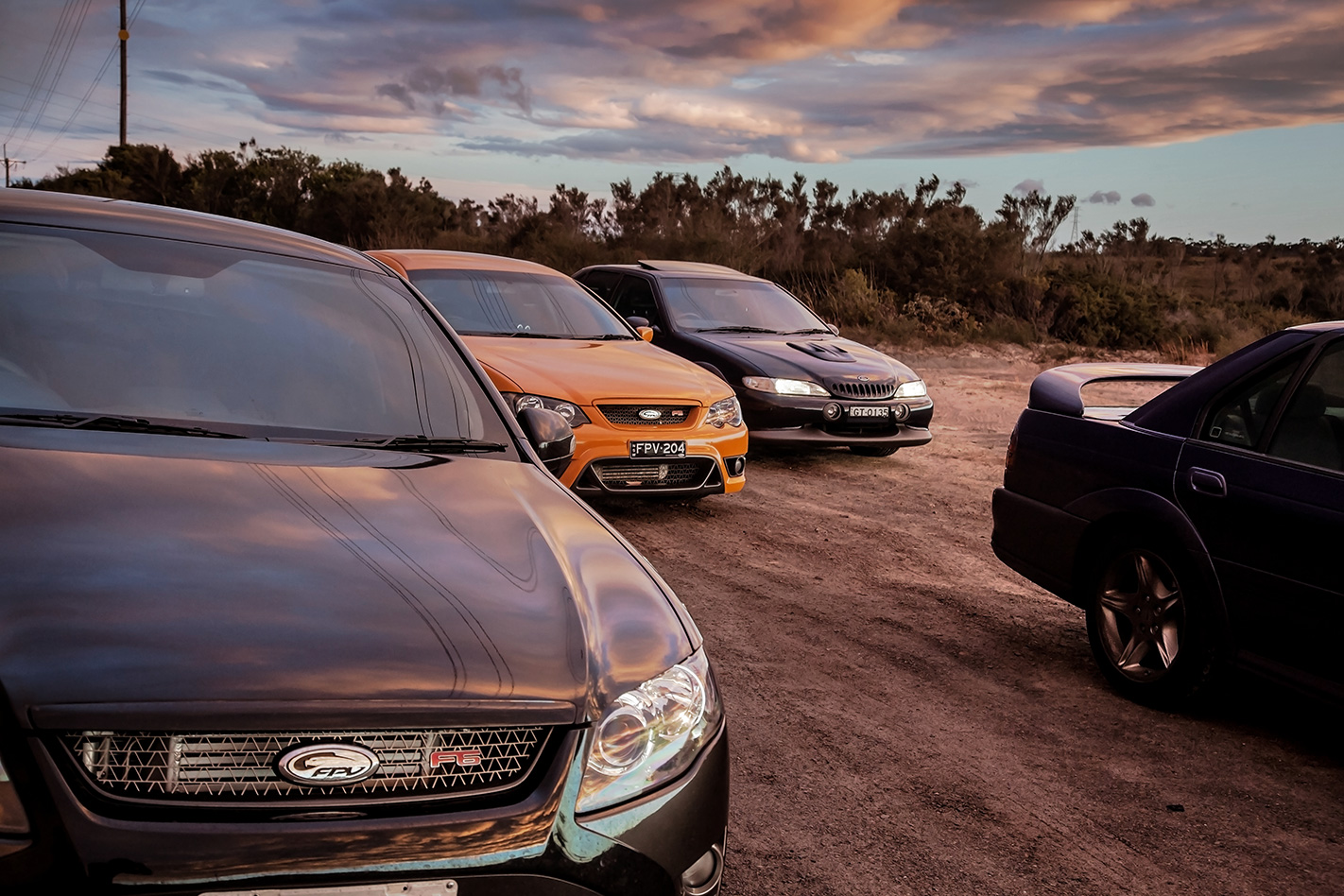
By the late ’90s, HSV abandoned the Aussie 5.0-litre V8 in favour of the 250kW US-built 5.7-litre Chevrolet LS1, in the context of which, FPV’s ageing 5.0-litre Windsor engine looked spectacularly underdone.
Meanwhile, both companies had struggled to strike a middle ground between the subtly sporty and the outright lairy. The AU’s styling was hardly the basis for a muscle sedan, however with the TE50, which brought in AU V8 Supercar cues, TVE had done a decent job.
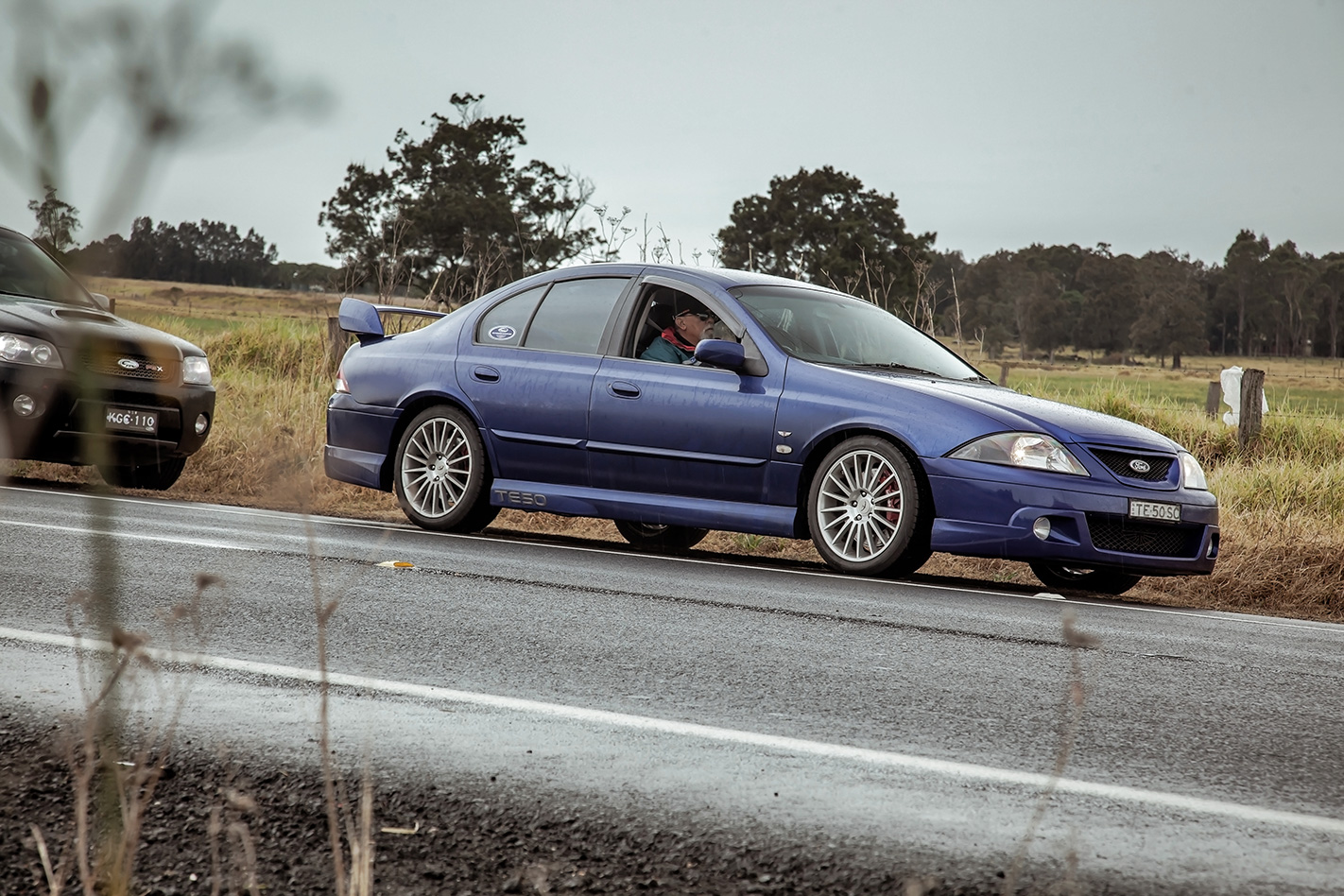
Developing the hand-built 5.6-litre ‘stroker’ from the 5.0-litre Windsor was no inexpensive exercise, but the result was a HSV-bashing 250kW and 500Nm and a fitting final iteration of a donk that dated to 1962.
Far more importantly than winning the spec-sheet stoush, the T3 T-Series was a genuine on-road match for its VX Commodore-based HSV contemporaries. Road-testers of the day were sold on the thumping torque on offer virtually from idle, which came backed by a delicious V8 grumble and crisp exhaust note.
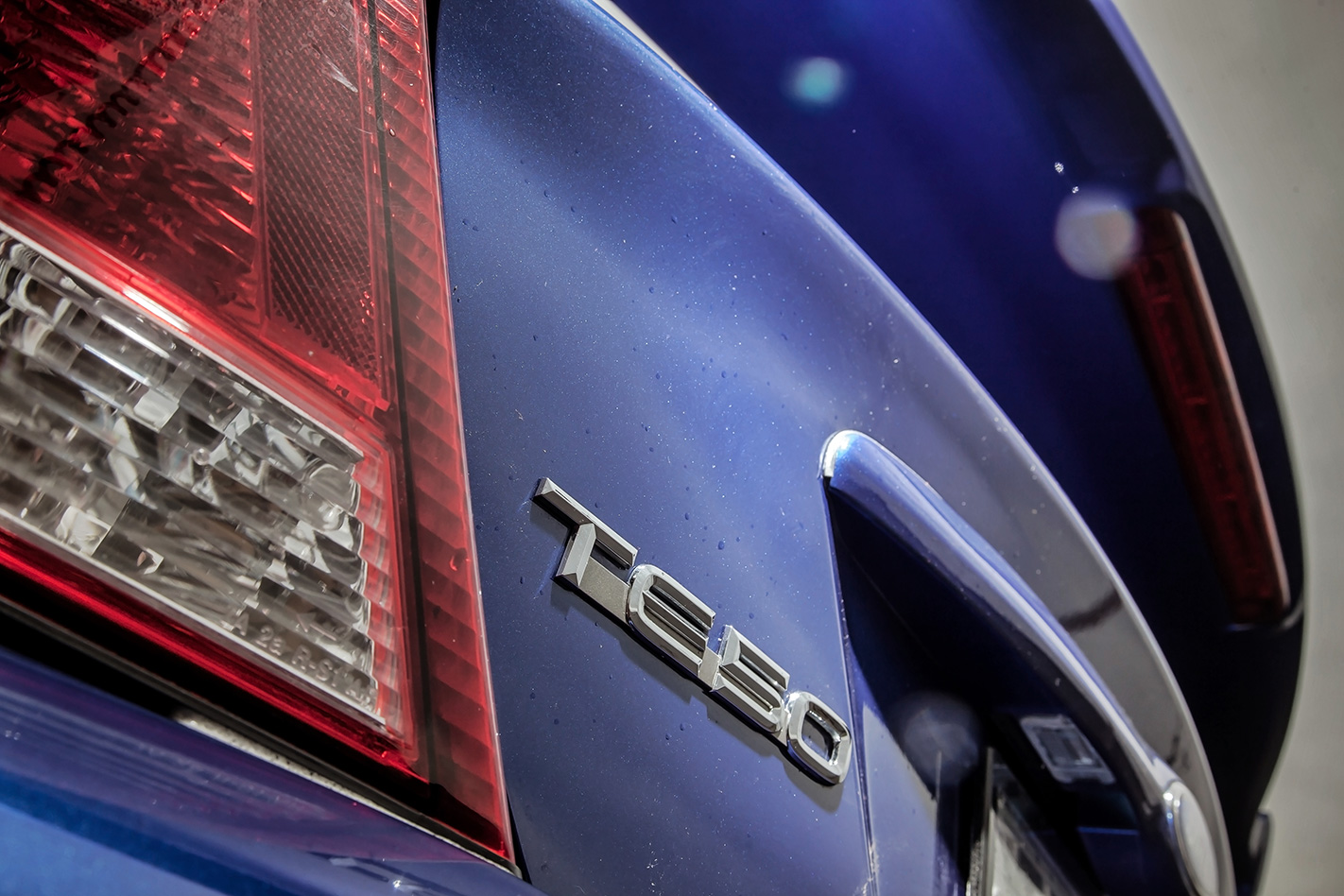
TVE built 204 TEs, 200-odd TSs and just 3 TLs, with four-speed automatic and five-speed manual transmissions. “The last count that I heard, at the T-Series Nationals in February at Bathurst there’s about 170 left on the road – and that’s Australia, New Zealand and South Africa,” says TE50 T3 owner Steve Carter (see breakout).
The Tickford Group’s sale to Britain’s Prodrive in 2001 signalled the end of Tickford Vehicle Engineering. In 2002, Ford Performance Vehicles was established as a partnership between Prodrive and Ford Australia. Ford’s BA series, which arrived in September that year, marked a turning point for Falcon, despite the fact it was a substantial $500 million redesign of the AU rather than a new-generation model.
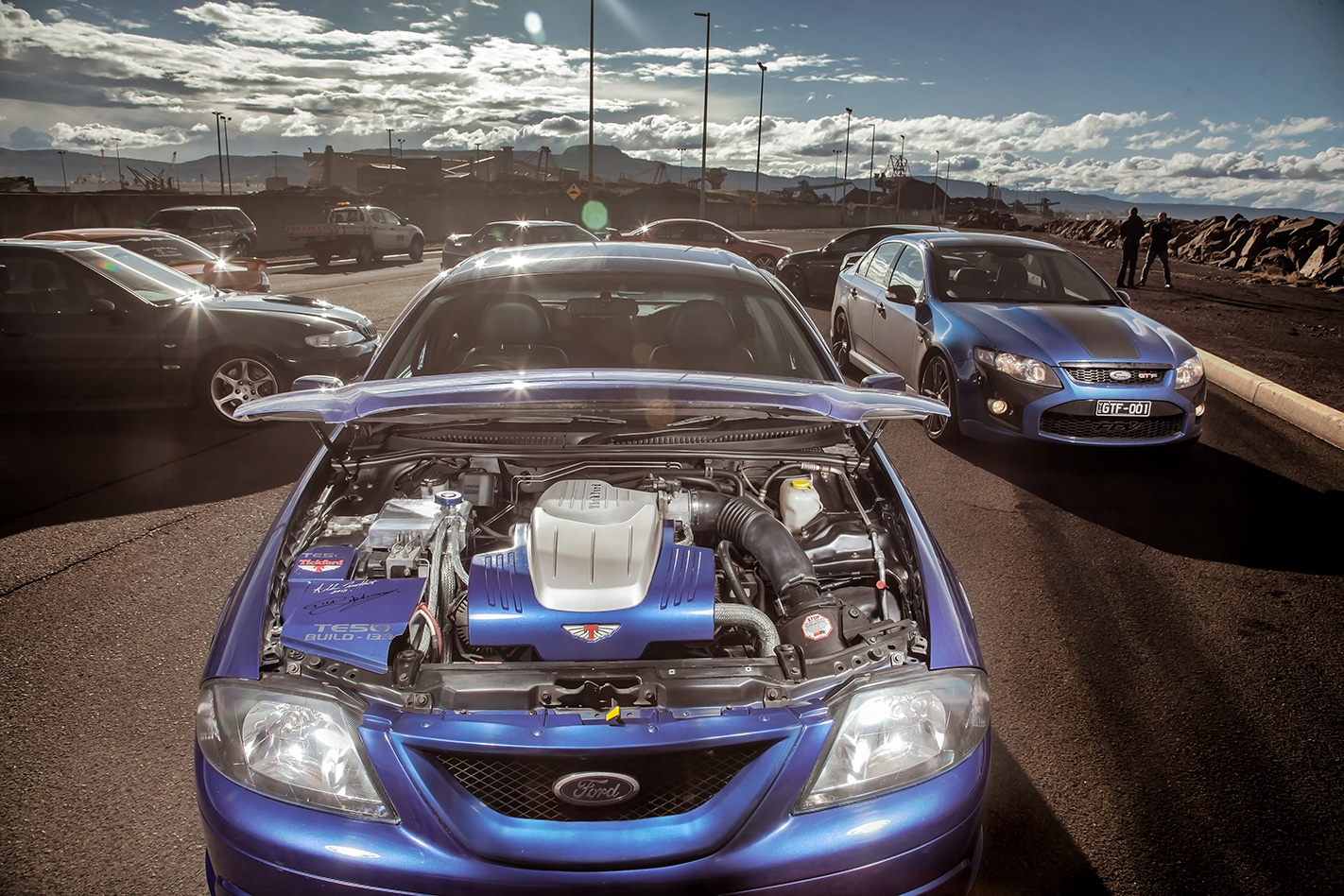
Just as excitingly, there was again a factory-backed team in local Tin Top racing in the form of the Ford Performance Racing V8 Supercars outfit. Prodrive had bought Glenn Seton Racing, renaming it before expanding its driver line up to include Craig Lowndes and David Besnard, and relocating into a new headquarters next to FPV’s Campbellfield, Victoria facility.
This reinvigorated motorsport effort was designed to draw a link between FPV vehicles and V8 Supercars. Meanwhile, the styling of the road cars tied them to the BA V8 Supercar.
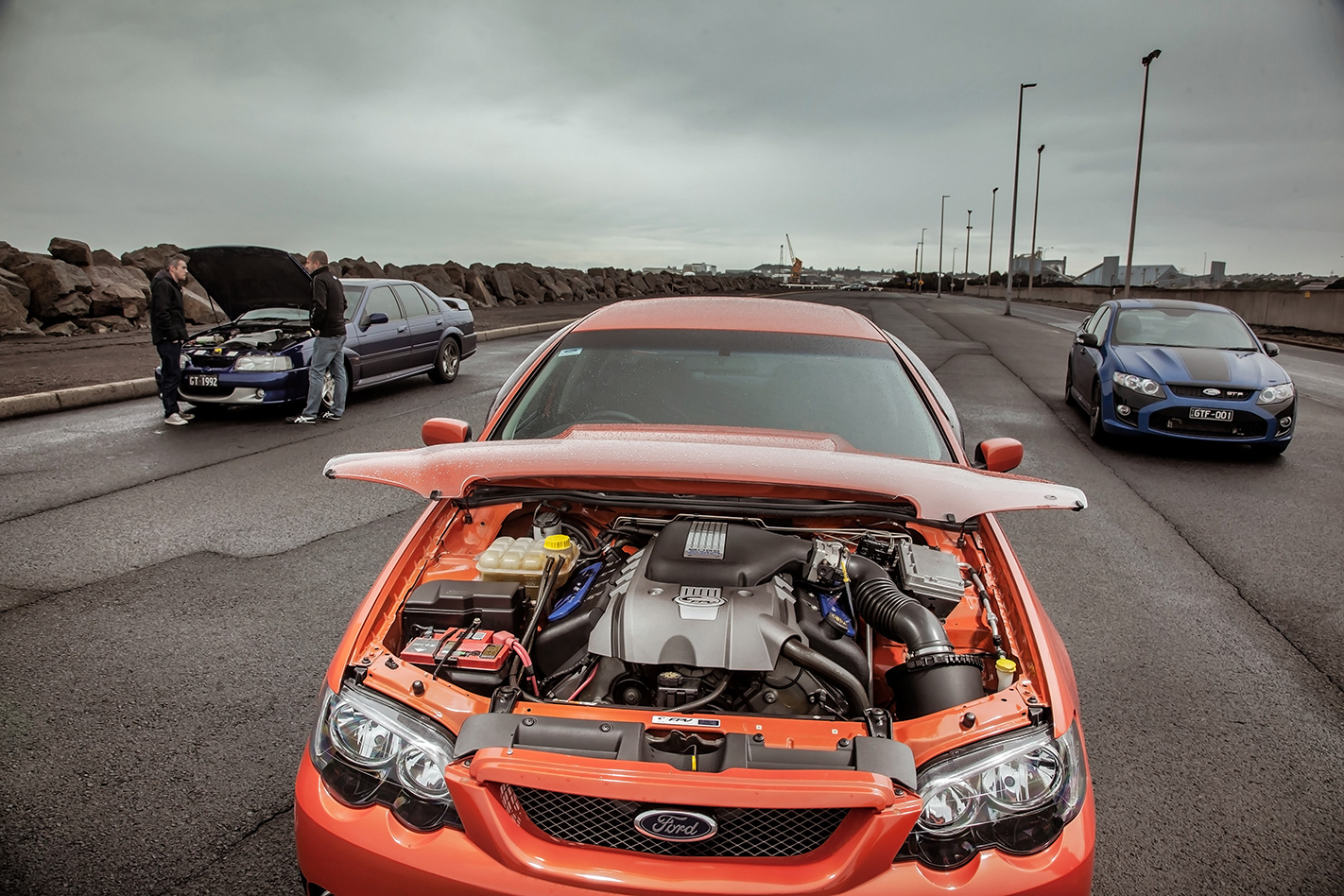
Slick, precise steering and innate rear-drive balance were strong points, but the chosen spring and damper rates left room for improvement. TE50 owner Steve’s assessment matches those of many road-testers at the time. “We had a BA GT – nice car – but I found the suspension and steering shithouse. It was all over the place like a mad woman’s breakfast.” Okay, so the journos weren’t quite so harsh, but you get the idea.
The Boss V8, while technically superior to the Windsor, needed to be extended for its deep breathing top-end to hit its stride. But the truck-derived bottom-end wasn’t exactly rev-happy.
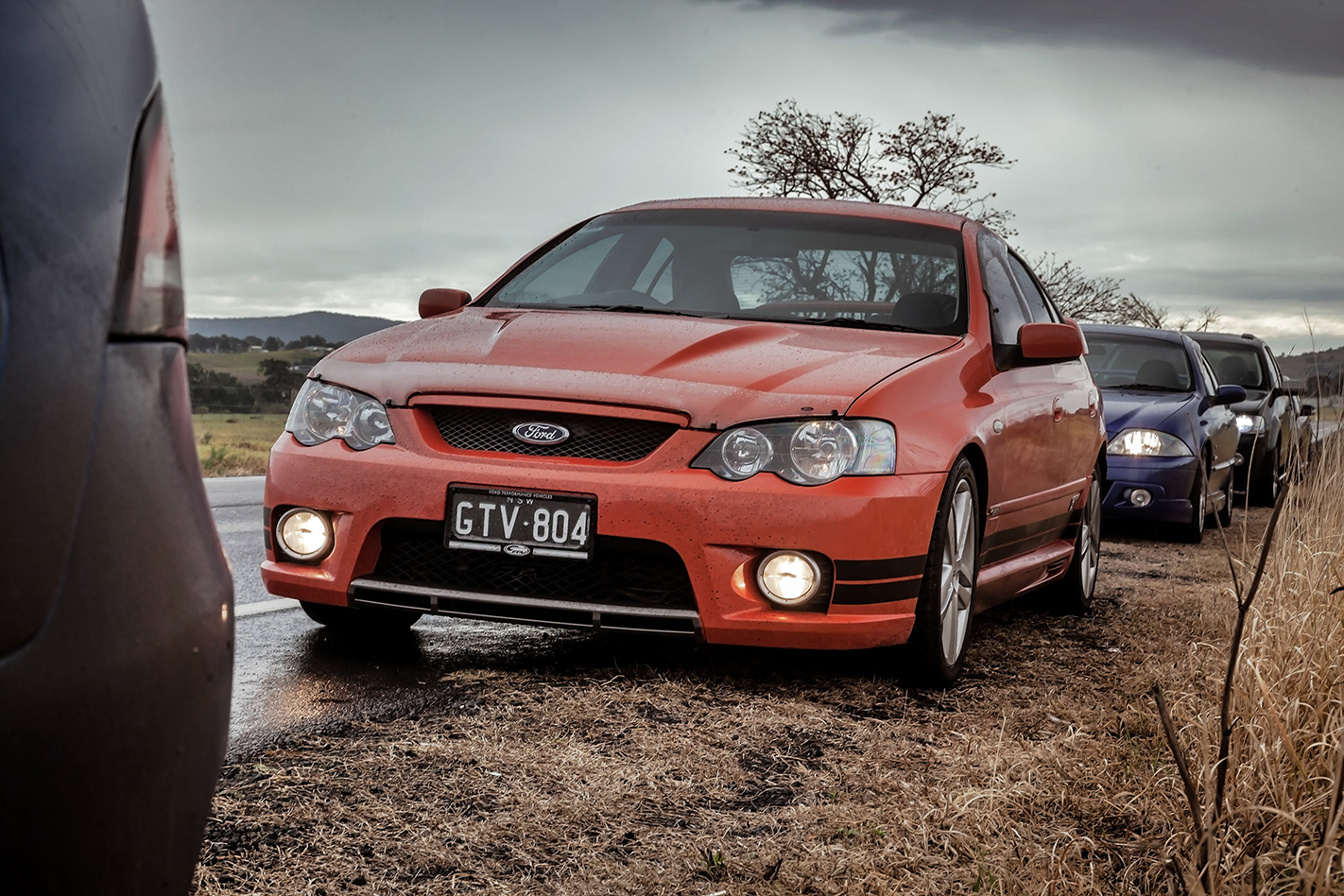
“This result is proof that the outstanding BA Falcon was the perfect platform to rekindle the passion for the GT,” said then-Ford Performance Vehicles Managing Director, David Flint.
“Our customers have made it perfectly clear that FPV has developed a credible vehicle to carry the legacy of one of the country’s most revered motoring names. We have re-created the essence of a GT, but with class-leading technologies such as the quad-cam Boss 290 V8 and control blade IRS”.
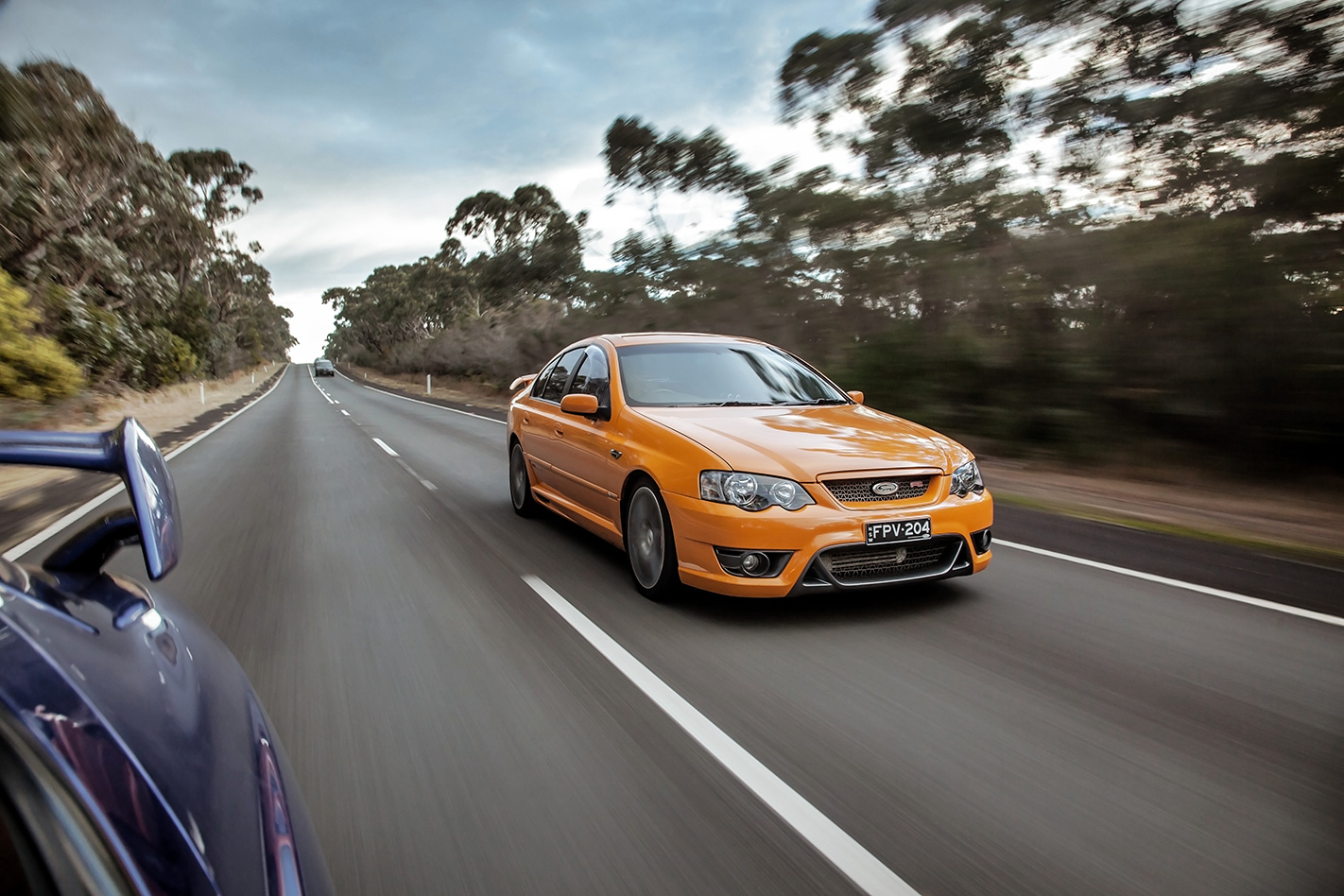
BA GT owner Rob Maricic’s solution was simple enough. “I owned an XR6 Turbo and then I thought, it’s time to get an eight. The XR6 is a runabout – the GT comes out for shows.”
It was the other way round for Typhoon man Tony Cordina “I originally went for the turbo and they only had the Boss 260 – I ended up buying that. Then I traded that in and ended up getting the Typhoon. It’s a lot better than what the Boss was – it’s a lot more responsive.”
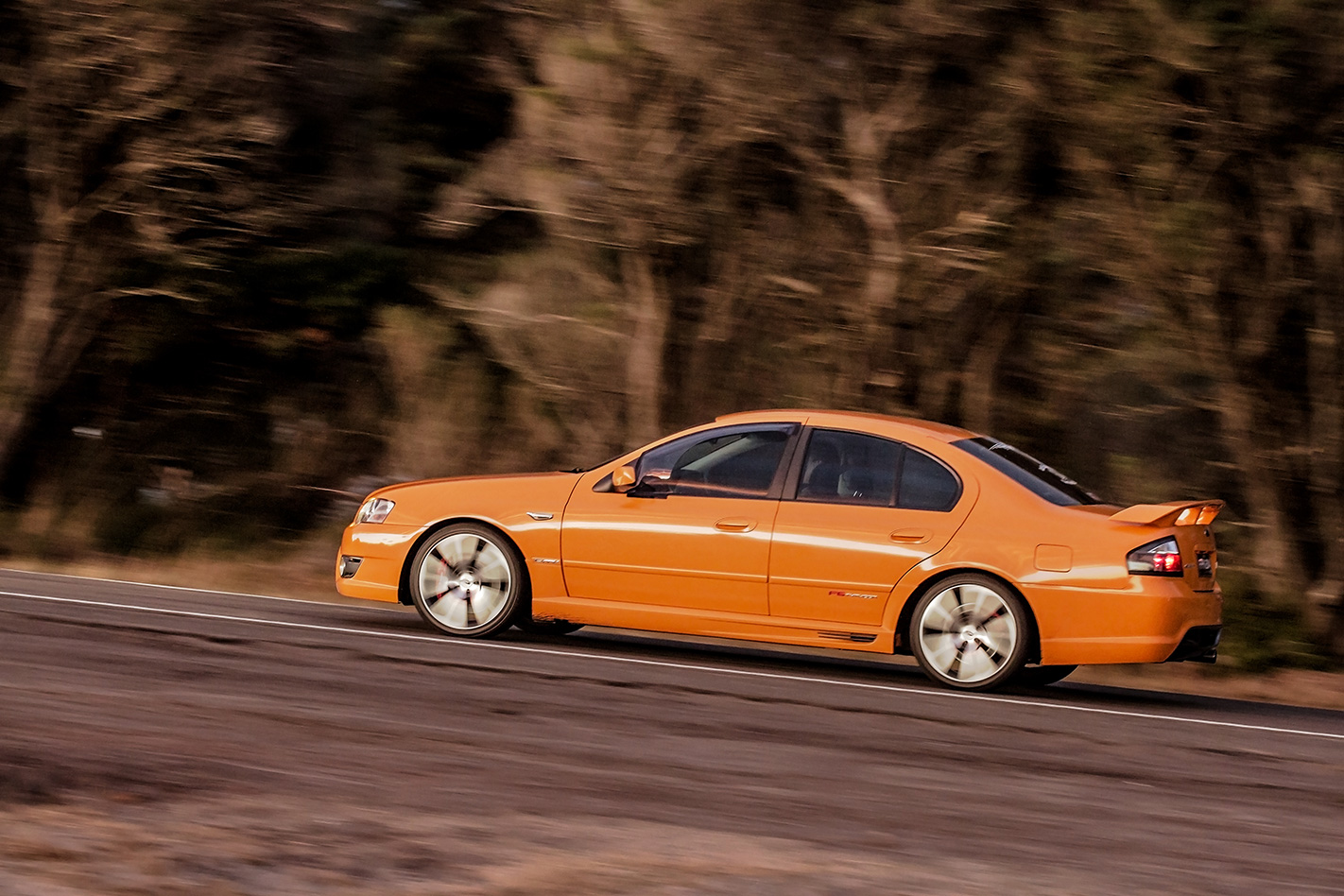
The BAII also brought new variant the Super Pursuit – a Pursuit ute equipped to GT-F spec – and an upgrade to 19s for the GT-P.
On the track, the big-budget FPR largely struggled to generate results. A Phillip Island round win for Lowndes in 2003 and second at Bathurst in ’03 and ’04 for Lowndes/Seton were the highlights. Like a Collingwood supporter, the fans stood by their side regardless, and would (eventually) be repaid for their loyalty.
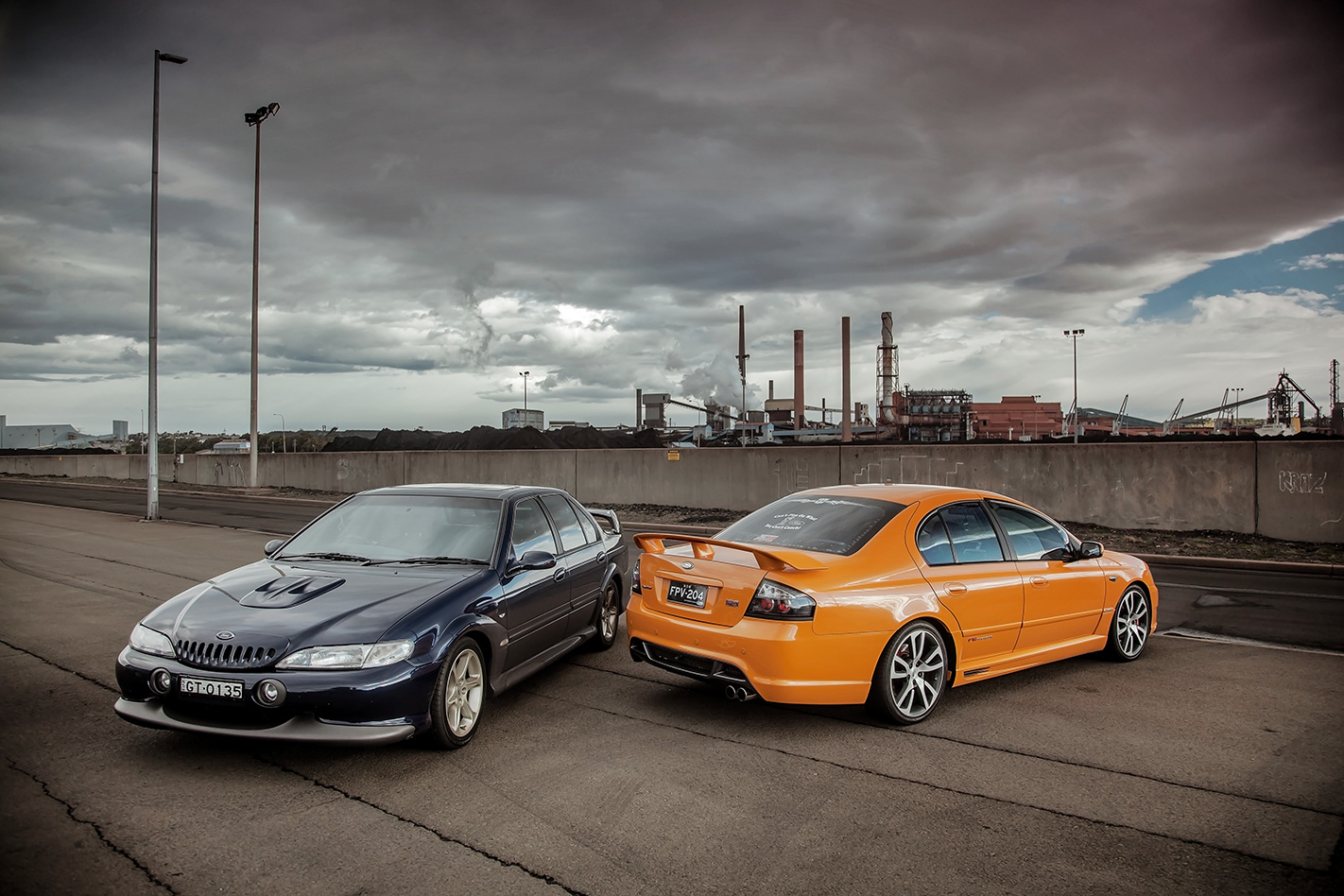
In 2006, the BF MkII saw 19s fitted across the range and a pair of new variants designed to take on HSV’s Senator, which had the hi-po luxo segment all to itself since 1992. The Force 6 and Force 8 wrapped GT and F6 Typhoon running gear in a more restrained visual package – think Fairmont Ghia with grunt.
In the last months of BFII production, FPV unleashed three limited editions. The XC Falcon-inspired GT Cobra and Cobra ute, questionably named F6 Typhoon R-Spec (arse peck?) and XR GT commemorative GT 40th Anniversary. All three were upgraded with firmer R-spec dampers, while only the Cobra copped a power increase, to 302kW and 540Nm.

The limited editions were timed impeccably to capitalise on the classic muscle car boom, and the Cobra and GT 40th in particular whipped buyers into a frenzy, some of whom paid well over sticker price to own one. Unfortunately their values today don’t necessarily reflect that brief period of cashed-up craziness.
With the muscle sedan market a success, 2008 marked an attempt at diversification by Campbellfield Crew – an FPV SUV.
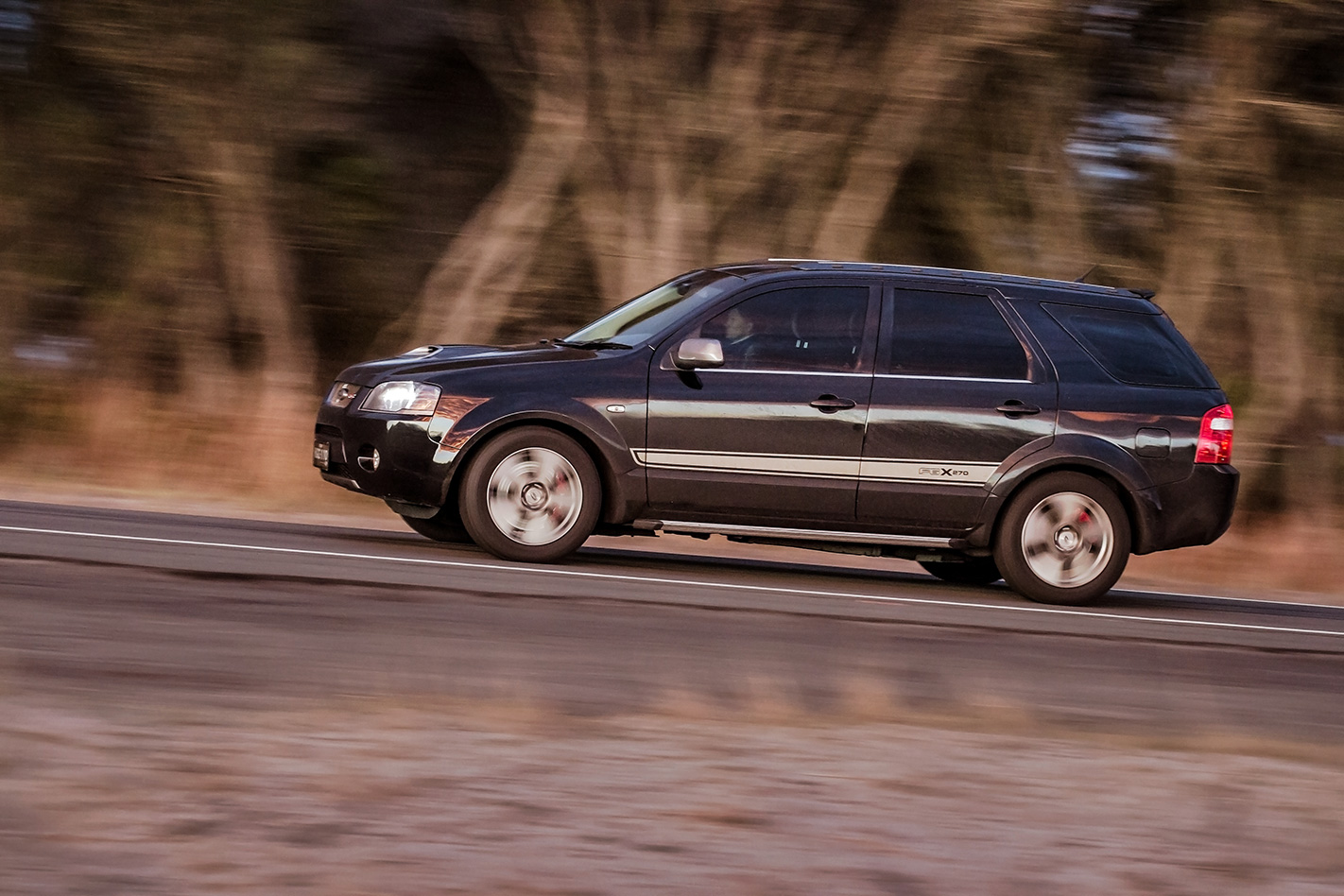
There were a few factors at play, but it wasn’t that the F6X was an inherently bad car. In fact, with a 270kW F6 turbo six powering all four wheels via a ZF six-speed auto and a relatively classy cabin treatment, it was an appealing package, as owner Kate Clark and her family found (see breakout).
“There is nothing wrong with the car,” said then-FPV General Manager Rod Barrett in 2009. “It is a great car, (but) it was the right car for the wrong time. The thing that has led to the decision we have made is that it was never aesthetically different enough from the mother car and probably had a price-tag that didn’t suit the market when it was launched.”
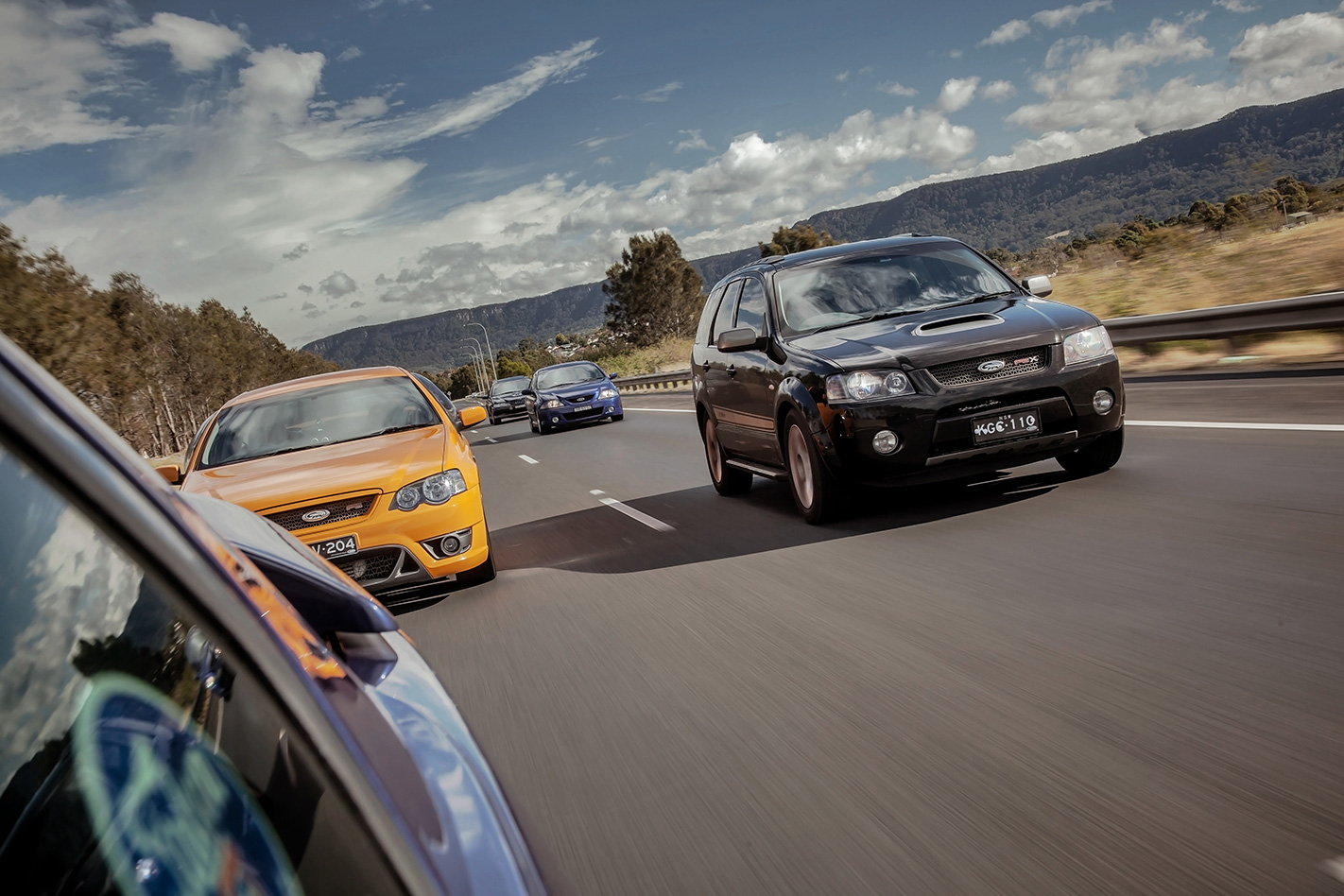
FPV club president Ben Schibeci’s FG F6 310 illustrates that point perfectly – the factory standard black automatic sedan is quicker than the heavily modified blown V8 BA it replaced in his garage (see breakout).
On the V8 front, Ford’s FG XR8 was upgraded to a Boss-spec 290kW and 520Nm. But Euro IV emissions regulations saw the XR8 and its bent eight phased out not long after, in June 2010.
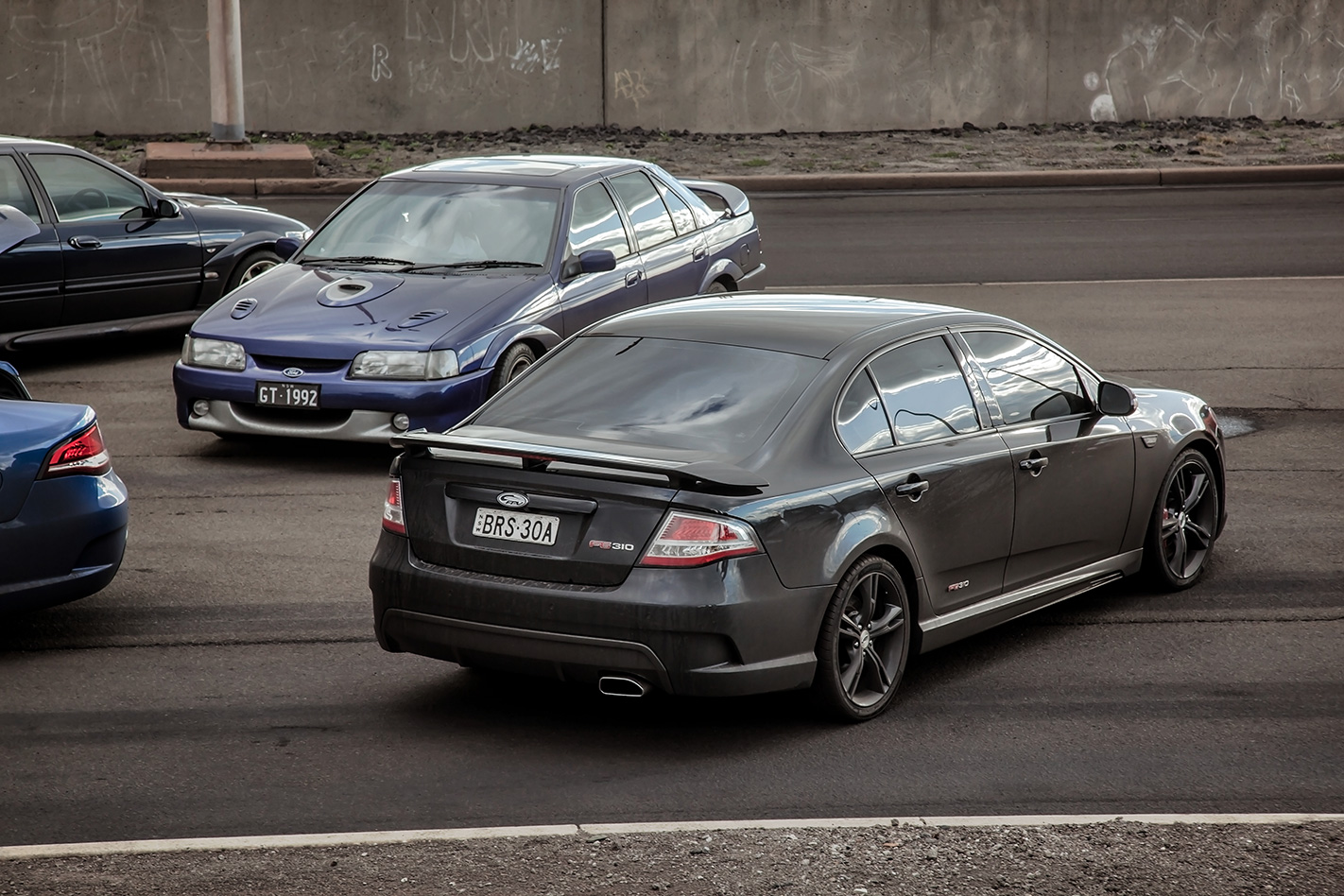
The new mill – also known as the ‘Miami’ – reportedly cost $40 million and was three years in the development, but brought to flagship V8 models newfound effortlessness and low-rev punch with the outputs – and outright pace – to take the fight to HSV’s 325kW naturally aspirated Chevrolet LS3-powered E2 and E3 GTS.
With the XR8 gone, FPV filled the void with its limited edition GS – a more affordable variant detuned to 315kW (2kW less than an HSV Clubsport) and 551Nm. The GS series revived yet another classic pair of letters, which had first been applied in 1969 for an XW Falcon option pack. Elsewhere, the line-up looked familiar, including a new GT R-Spec, while new F6-E and GT-E variants took the place of the Force 6 and 8.
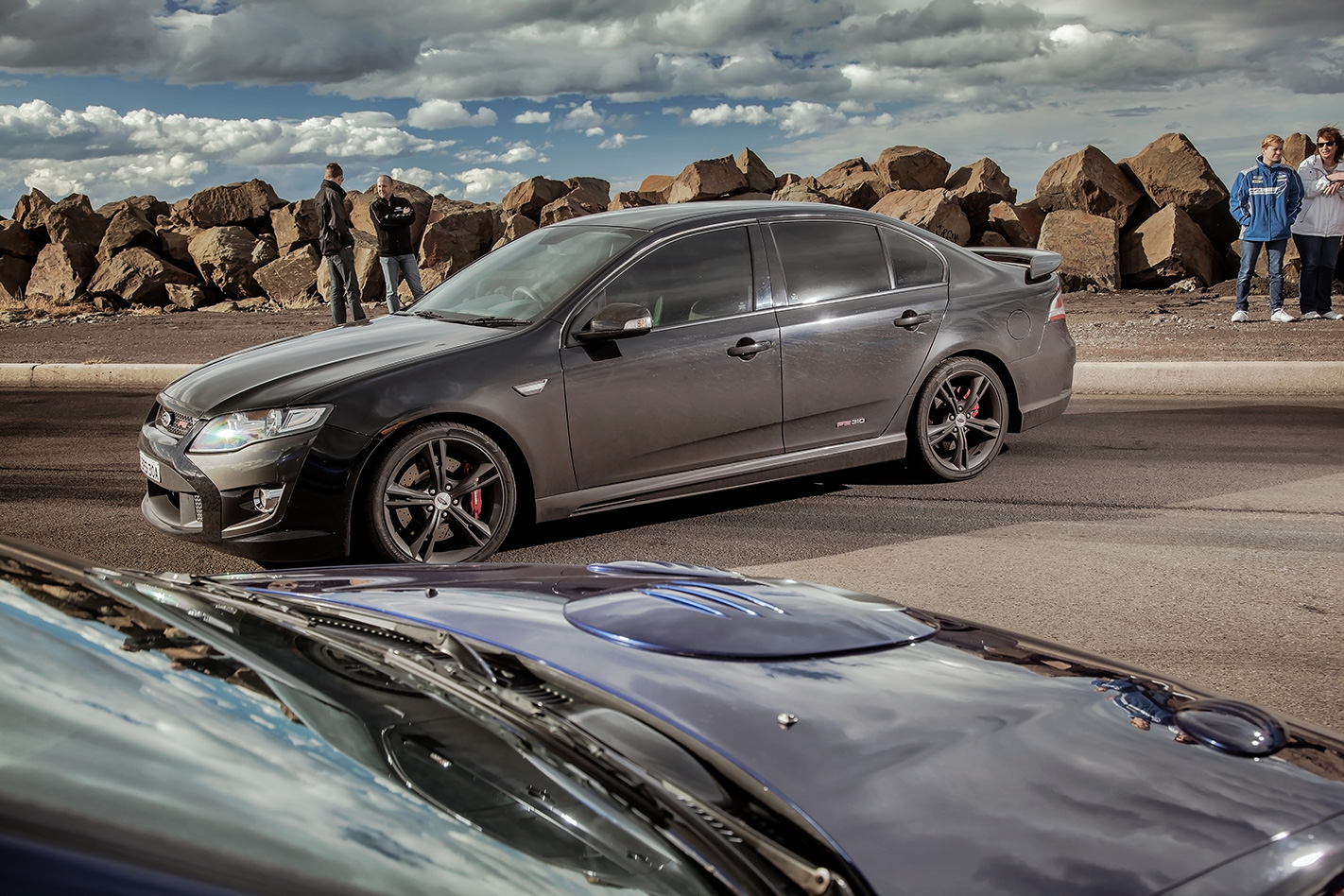
Jobs were lost as engine production shifted to Ford’s Geelong plant and vehicle assembly moved under one roof at Campbellfield. Ford boss Bob Graziano wasn’t giving much away.
“It’s too early to talk about any changes to the portfolio, and for the foreseeable future from an FPV prospect perspective they won’t see a significant change in the line-up.” However, in hindsight it’s clear that, with the writing on the wall for FPV, its best – and last – Falcon was in the works.
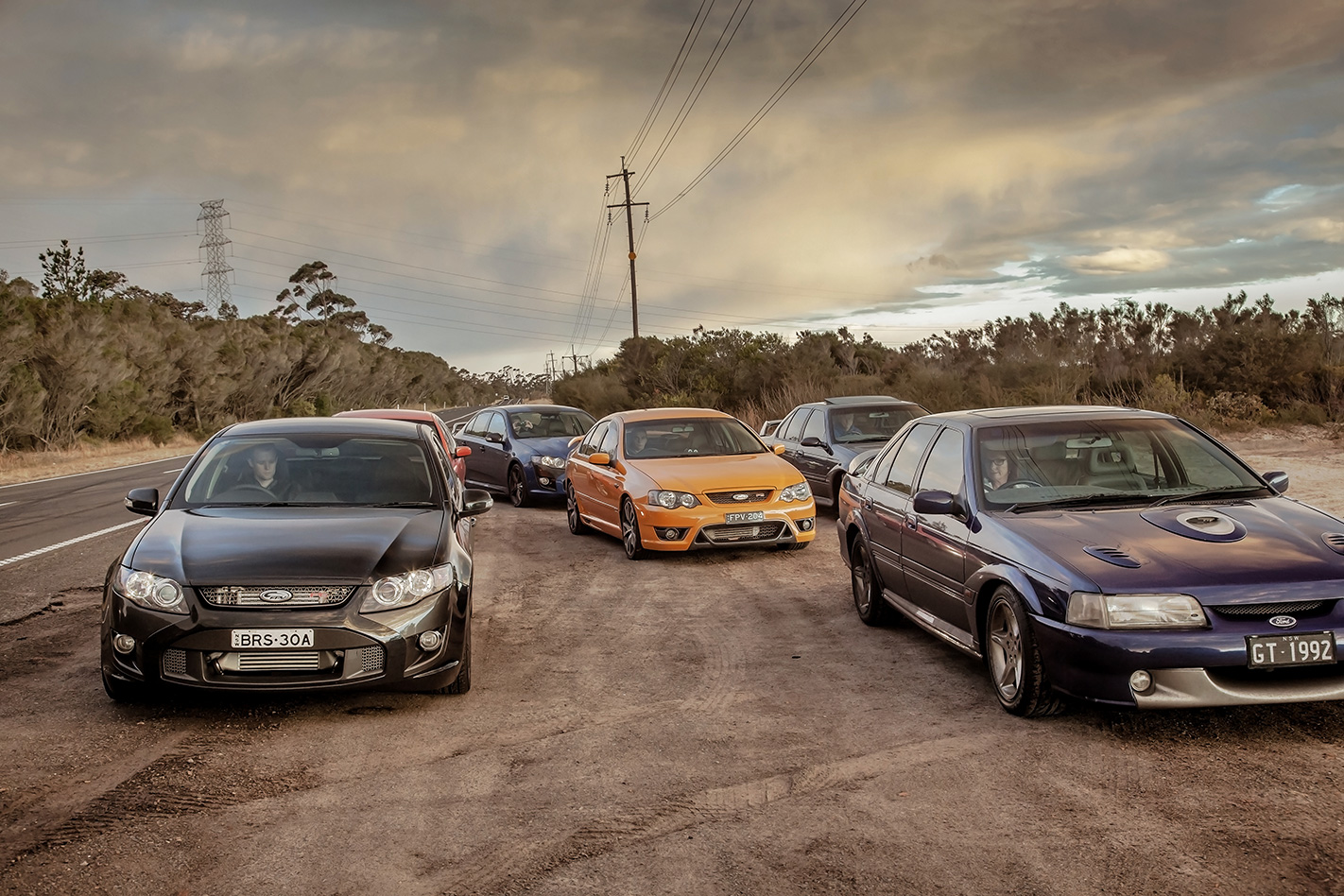
With last F6 stocks delivered earlier this year, and a facelifted Falcon due at year’s end, the FPV turbo-six story came to an anticlimactic close. The FG Mk III’s silver lining is it will see the XR8 badge return until the end of Falcon in 2016. There’d be one last FPV.
FPV’s 2014 GT F marks 11 years of FPV and 22 years since the Tickford era began, and is the full stop on 47 years of the Falcon GT.
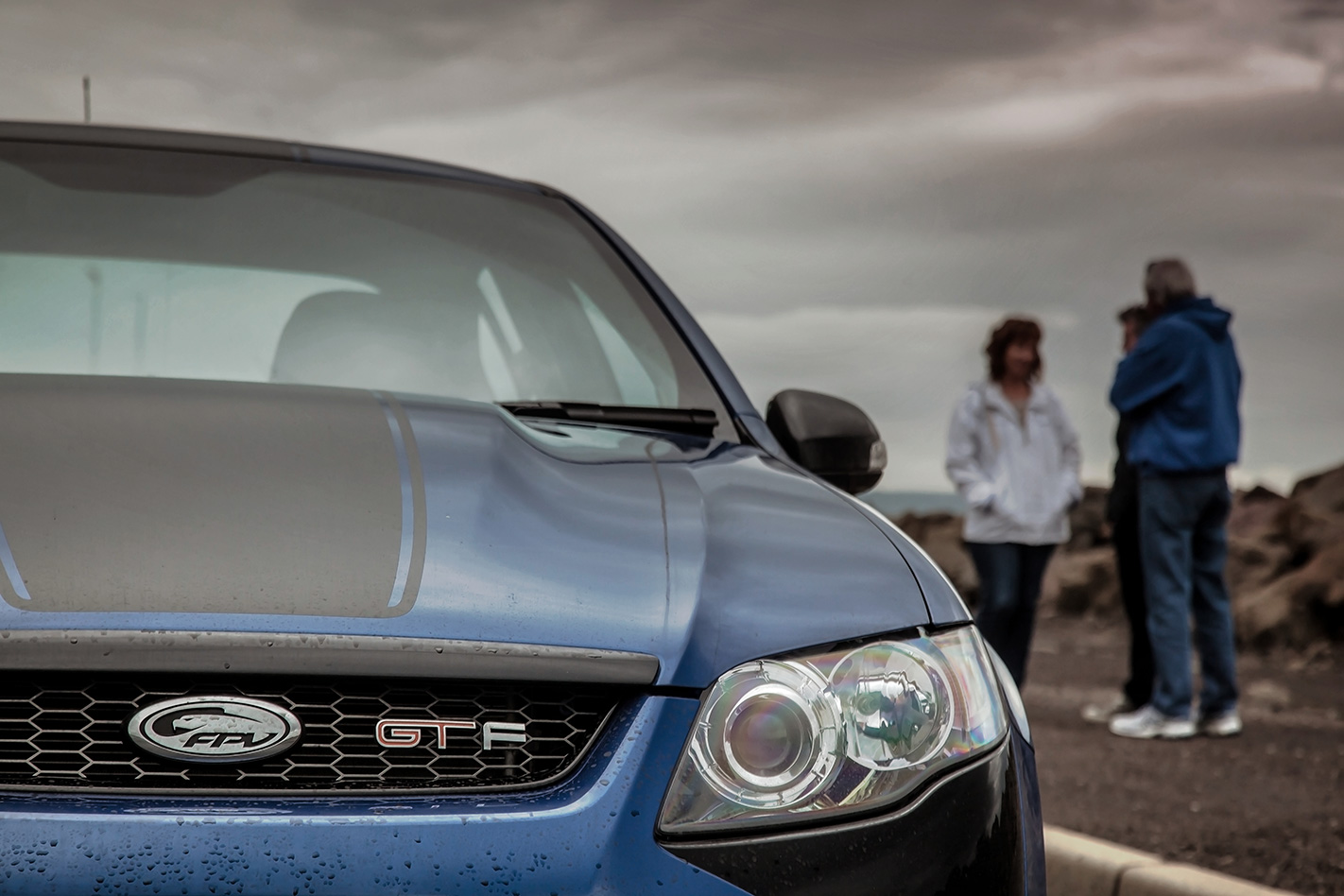
“All things come to an end I guess, but the way that manufacturing is in Australia I’m not surprised. I was surprised that they actually made it this far.
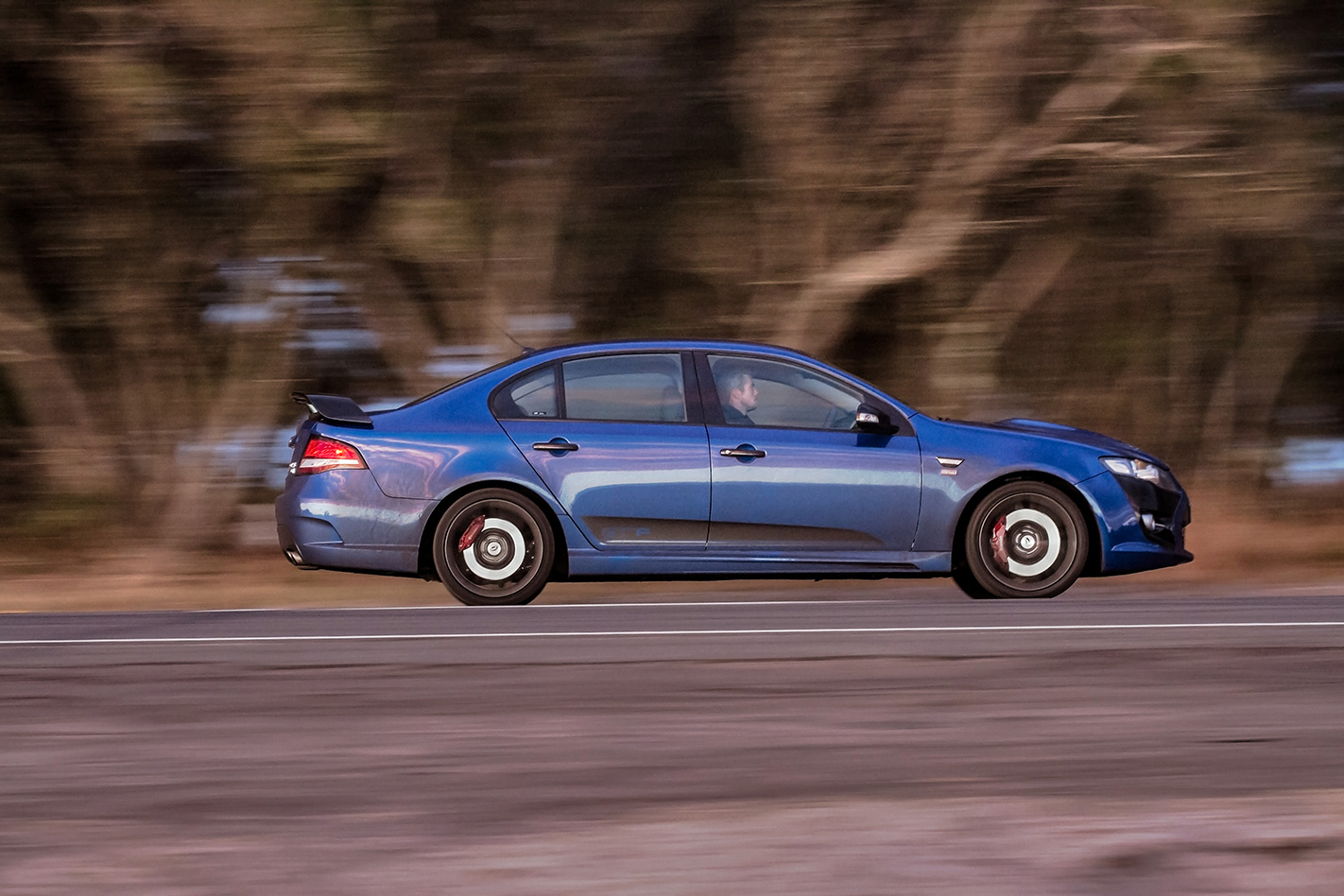
My personal opinion? It’s a fitting way to go. It’s the best Ford’s engineers could do with the budget they had.”
Our Heroes Big credit is owed to the FPV Tickford club of NSW along with Simon and Katrina Roche from the GT Club of NSW for providing all the glorious metal to be savoured on these pages. If you have an FPV and need a clan, head to fpvclub.com and falcongtclubnsw.com
Simon Roche – 1993 EB II GT
“Dad used to have a couple of big 351 Fairlanes, and as a kid my job was in the morning to pull the choke and start it up and have it warmed up ready for him to go to work. I think Bathurst as well, y’know, I’ve got the Ford 1-2 poster at home – that’s probably where my love of Fords came from.
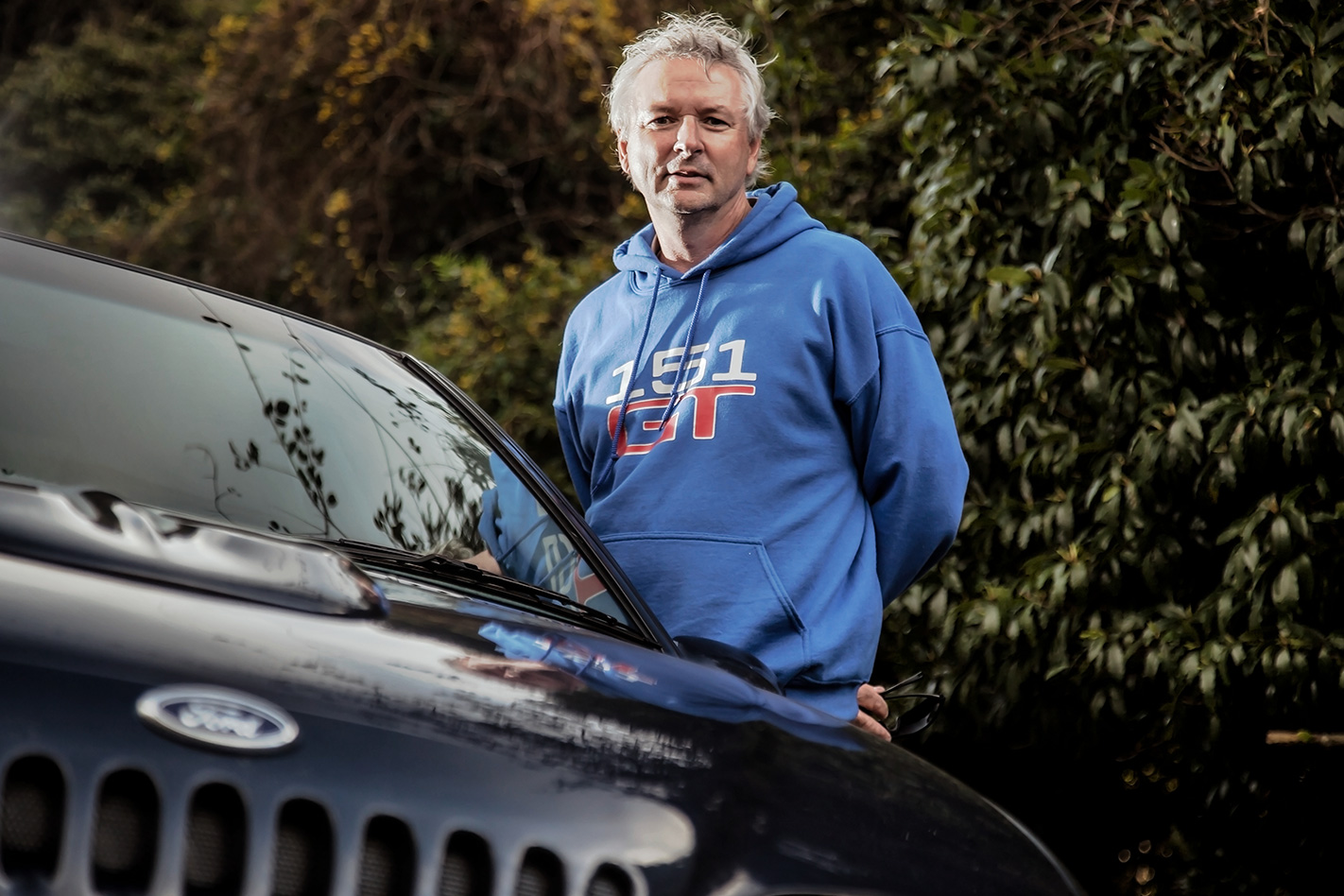
1993 EBII Ford Falcon GT Specs Price $62,500 (new) Engine 4942cc V8, OHV, 16v Power 200kW @ 5250rpm Torque 420Nm @ 4000rpm Kerb weight 1657kg 0-100km/h 7.3sec
Simon Roche – 1997 EL GT
“It was owned by a gentleman in Lithgow and it ended up in a consignment yard (in 1998) due to finances I think, and Katrina saw me looking at it in the yard and went ‘naah’.
She actually phoned [the yard] up and said we’ve got this Ford Raider, what do you think it’s worth, and they had brand new price on it – 75 grand – and she said I’ll give you 50 grand change-over. I laughed at her and said they won’t do that, and they did. It only had 2000 kays on it.”
1997 EL Ford Falcon GT Specs Price $69,500 (new) Engine 4942cc V8, OHV, 16v Power 200kW @ 4700rpm Torque 420Nm @ 3700rpm Kerb weight 1699kg 0-100km/h 6.9sec (claimed)
Steve Carter – 2002 TVE TE50 T3
“My first car was an FJ Holden, like most young blokes – I’m nearly 66 years old. My first Ford was a 1963 imported English GT Cortina and that’s where my love affair with Ford started. My eldest daughter bought and XR8, and I fell in love with ’em. We bought a series 1 XR6 – lovely car – and we just graduated. I saw the T-Series come out, I thought that’s nice.
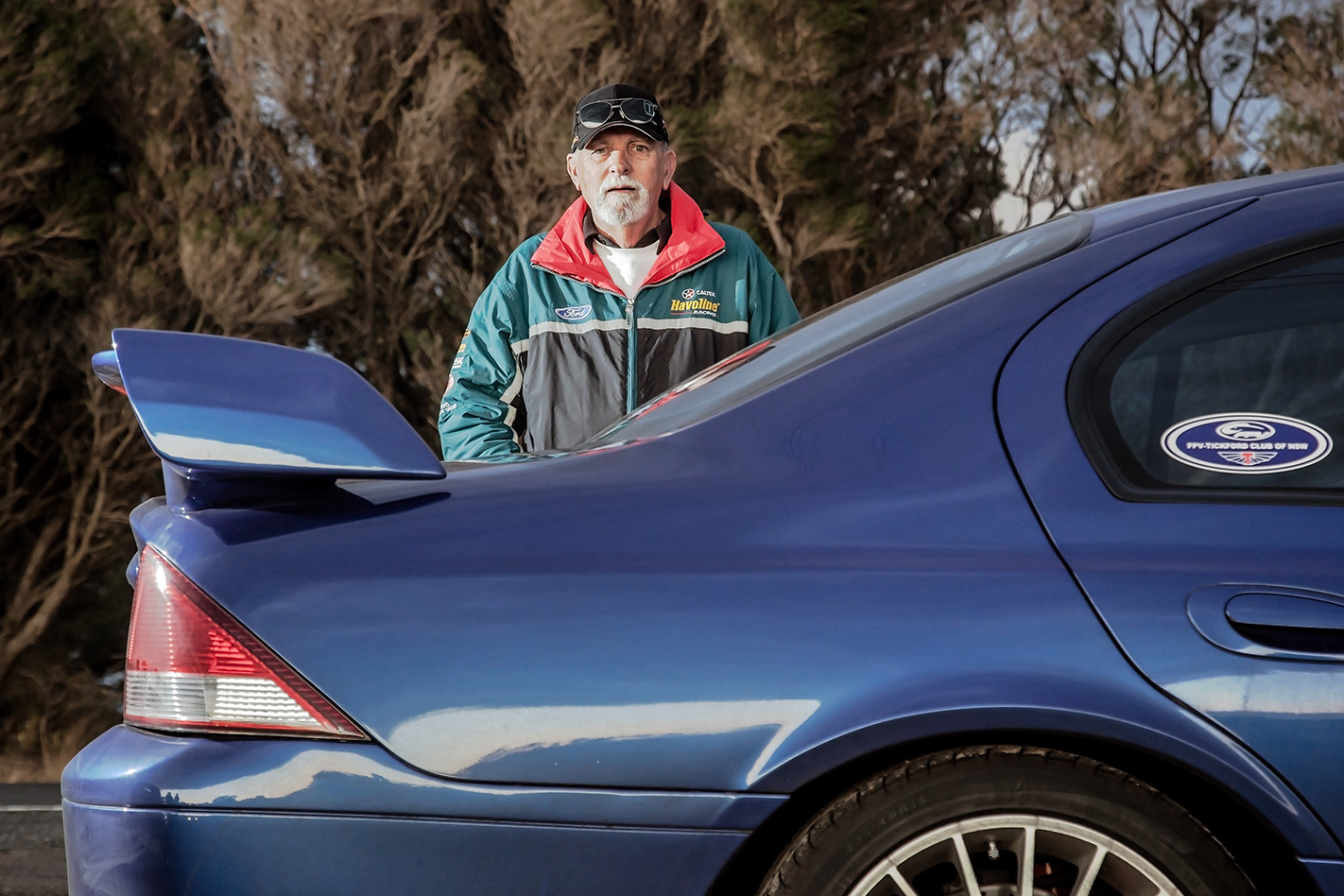
2002 TVE TE50 T3 specs Price: $58,350 (new) Engine: 5604cc V8, OHV, 16v Power: 250kW @ 5250rpm Torque: 500Nm @ 4250rpm Kerb weight: 1720kg 0-100km/h: 6.0sec (claimed)
Rob Maricic – 2004 BA GT
“As a kid I grew up watching Bathurst – Moffat, Brock, Dick Johnson – Ford’s been in my blood since I can remember. This came on the market, it was well looked after one-owner, so I purchased it – I’m building a bit of a mini collection. I’ve put an order in for a GT F, so the garage is getting full. I’ve got a son who also follows Ford.
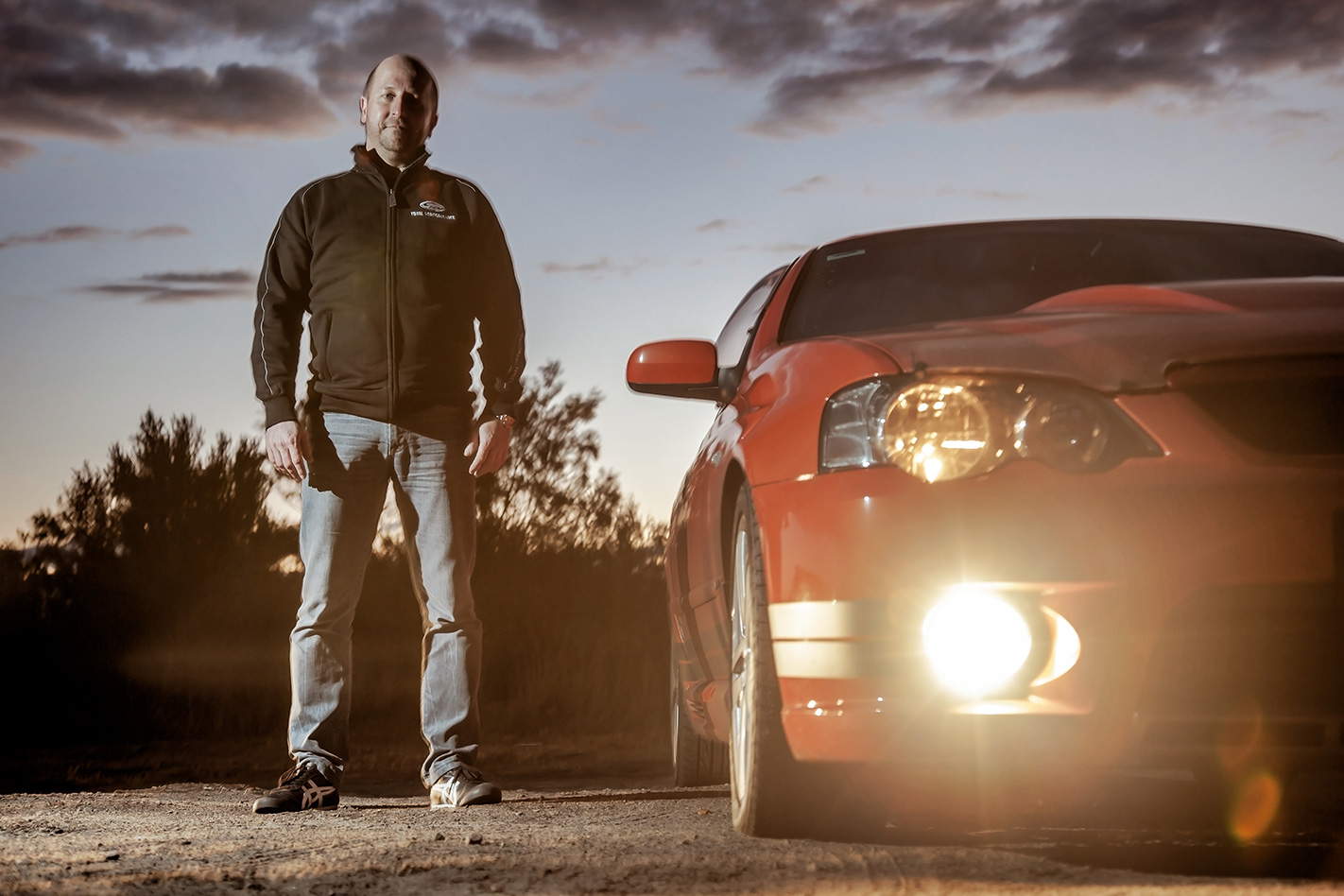
2004 BA FPV GT Price: $61,000 (new) Engine: 5408cc V8, DOHC, 32v Power: 290kW @ 5500rpm Torque: 520Nm @ 4500rpm Kerb weight: 1845kg 0-100km/h: 5.9sec
Tony Cordina – BFII F6 Typhoon
‘Can’t piss on what you can’t catch’ reads the sticker on the rear window of the BFII F6 Typhoon. You get the impression that for Tony Cordina, the F6’s appeal has as much to do with its untouchable bang-for-buck as its badge. Not that he’s any less the Blue Oval man than the next bloke. “I love watching the V8s. I’ve always had Fords since I started driving.”
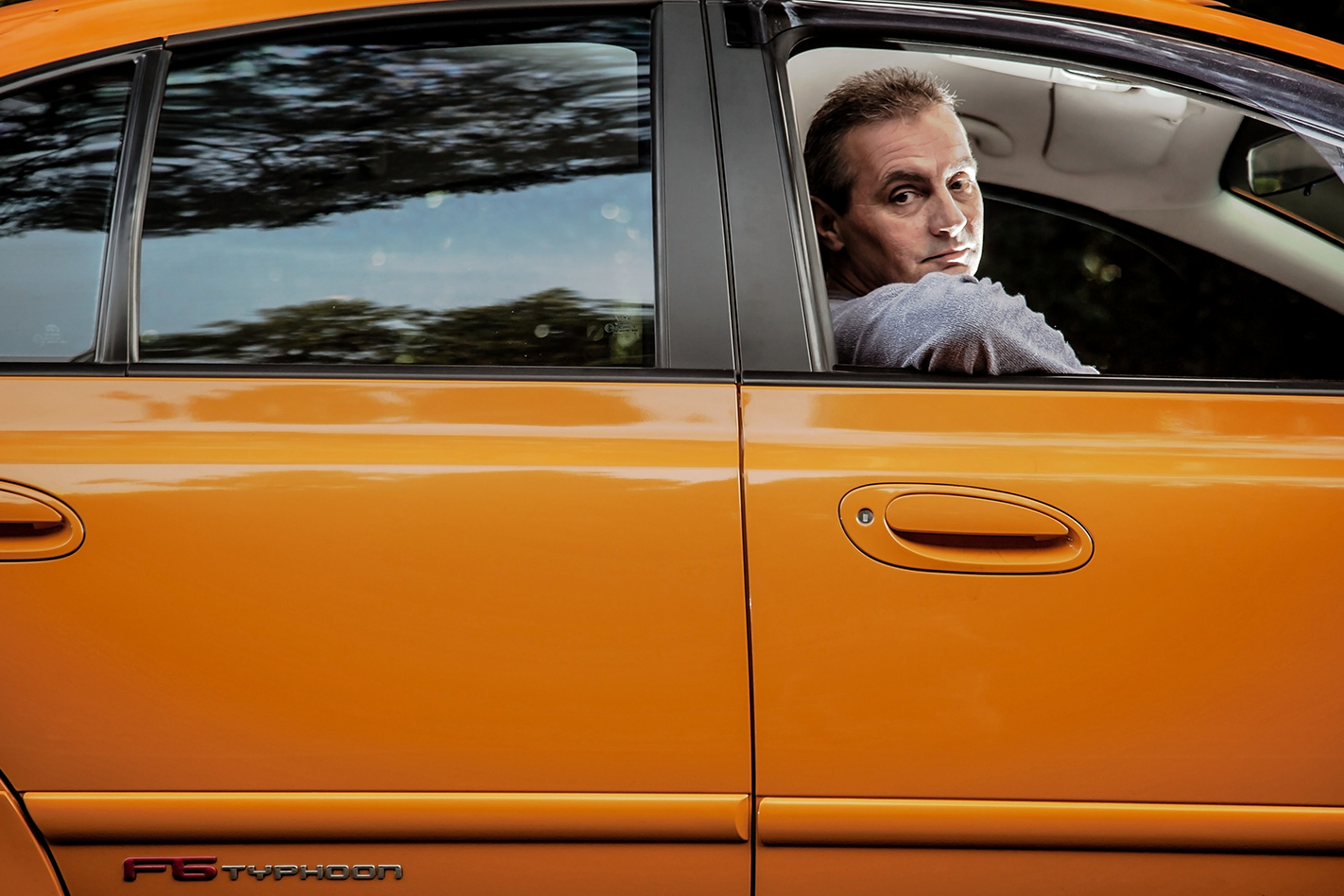
2006 BFII FPV F6 Typhoon Price: $61,810 (new) Engine: 3984cc in-line 6, DOHC, 24v, turbo Power: 270kW @ 5250rpm Torque: 550Nm @ 2000-4250rpm Kerb weight: 1815kg 0-100km/h: 5.7sec
Kate Clark – 2008 F6X
“I’ve grown up with Fords all my life, my parents have had FPVs; my parents have had GTs. I finally bought mine in 2008. It was my husband’s ex-demo – we ended up buying it because we needed seven seats for the kids, and I wouldn’t part with it. I’m a car nut – always have been always will be.
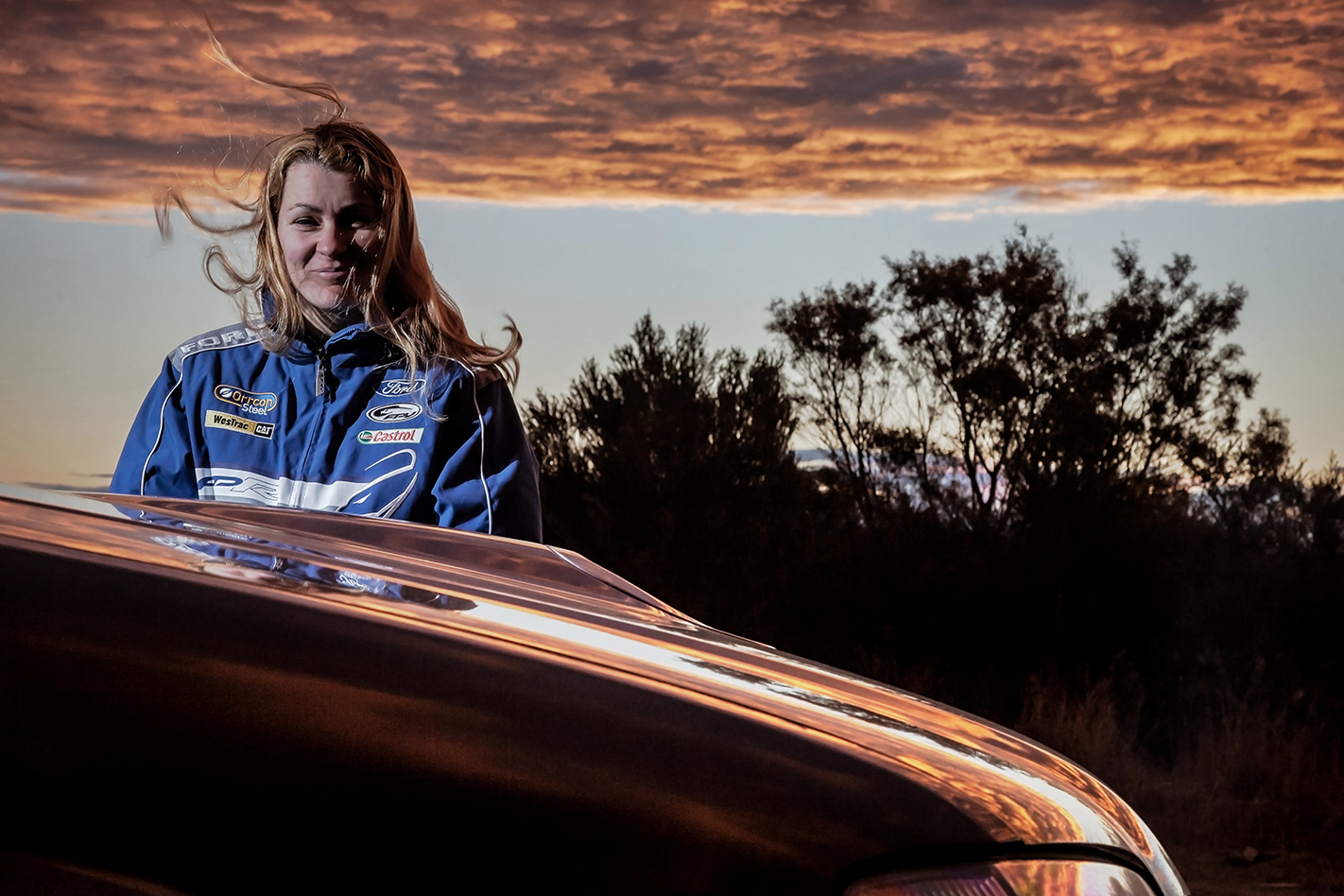
2008 FPV F6X Price: 75,990 (new) Engine: 3984cc inline 6, DOHC, 24v, turbo Power: 270kW @ 5250rpm Torque: 550Nm @ 2000-4250rpm Kerb weight: 2155kg 0-100km/h: 6.0 (sec)
Ben Schibeci – FG F6 310
“My dad’s got an old GT – an XA rusting away – so we’ve always been a Ford family; Ford people. As soon as I could afford one I bought an XR8.
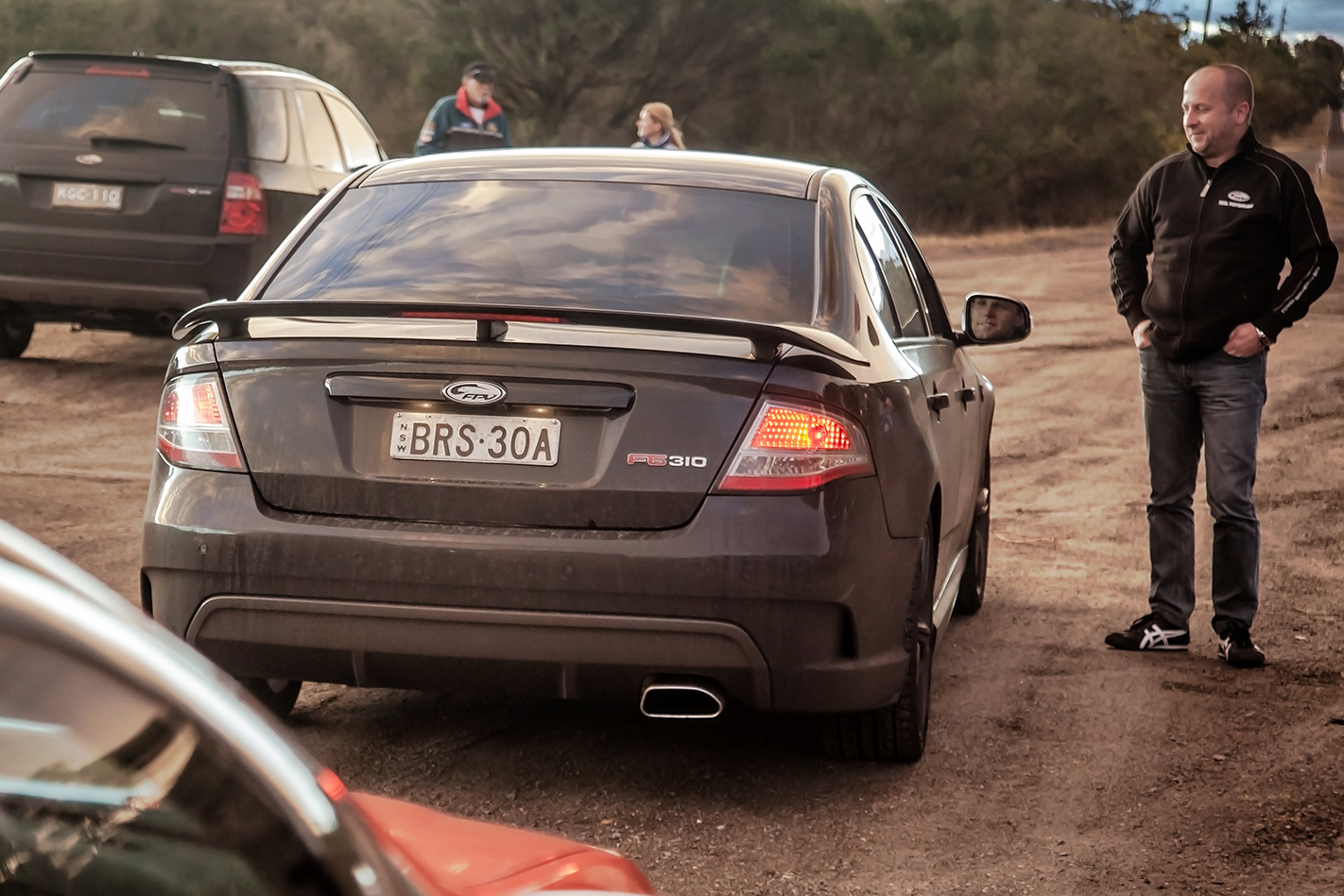
2014 FPV F6 310 Price: $64,390 (new) Engine: 3984cc in-line 6, DOHC, 24v, turbo Power: 310kW @ 5500rpm Torque: 565Nm @ 1950-5200rpm Kerb weight: 1778kg 0-100km/h: 5.1sec (tested)
Verdicts
EB GT Watered down return of the GT V8 was a slow seller. Mainstream collectability and appeal has eluded it, as has big-time appreciation, but rarity and first-of-the-series significance on its side today
EL GT Remembered for its out-there grille and body additions rather than game-changing performance. The GT had (again) gone soft, but paved the way for ultimate TE50 and birth of FPV
TE50 T3 It wasn’t until the third TE50 that TVE got the package right. T3’s ‘stroker’ 5.6-litre Windsor V8 a grunty cracker of a donk and more than a match for HSV rivals. AU styling proved more difficult to stroke
BA GT First-FPV significance with new-gen chassis and overhead cam V8 give the BA GT both collector and driver appeal, once you’ve upgraded the soft suspension. A massive hit back then and still holds enthusiast appeal
BFII Typhoon FPV’s each-way bet on the turbo six and V8 had well and truly paid off. Beloved of The Boys in Blue (for Highway Patrol duty) and Blue Oval fans. Typhoon’s enviable bang-for-buck even stronger now than new
F6X FPV’s foray into super-SUV realm didn’t pay off. F6X a well-sorted package but price tag and Territory Turbo-alike looks hurt its appeal. A limited edition, but this time build-count limited by demand, rather than supply
FG F6 310 F6 by now a fixture on Aussie hi-po landscape and perhaps the default local performance pick (over a V8). Storming grunt from the last ‘Barra’ 4.0-litre turbo-six
GT F Potent, 400kW-plus (on overboost) limited-edition muscle sedan a fitting FPV send-off. Great value at $77,900, if not the $100K being asked by opportunistic types. Run of just 500 (for Oz; 50 for NZ) should guarantee collectability

